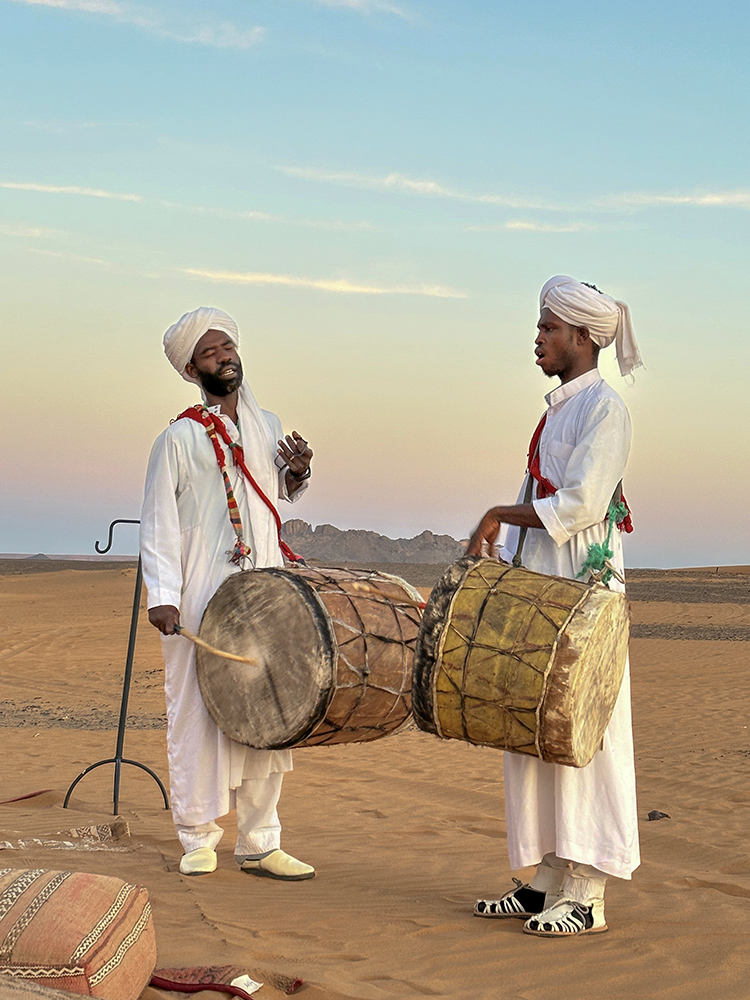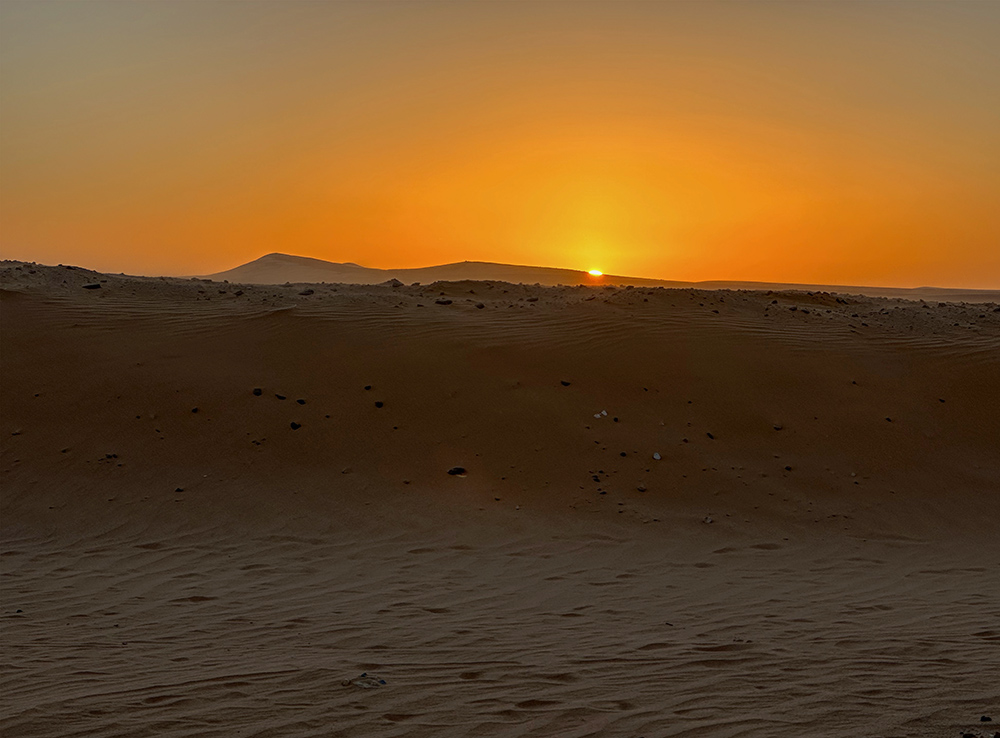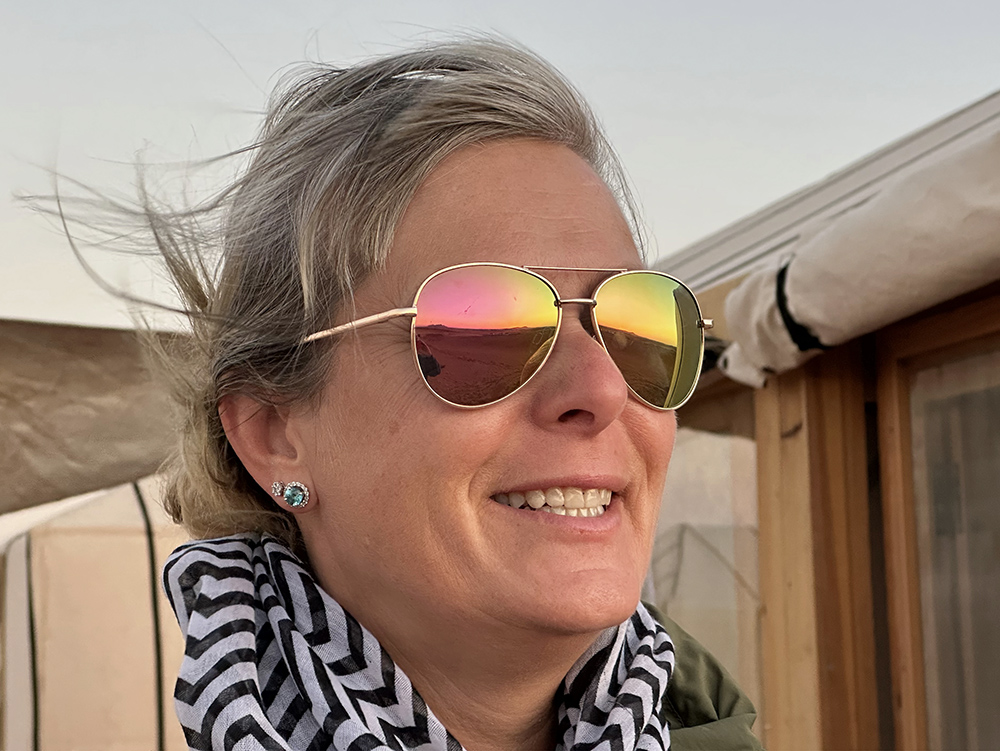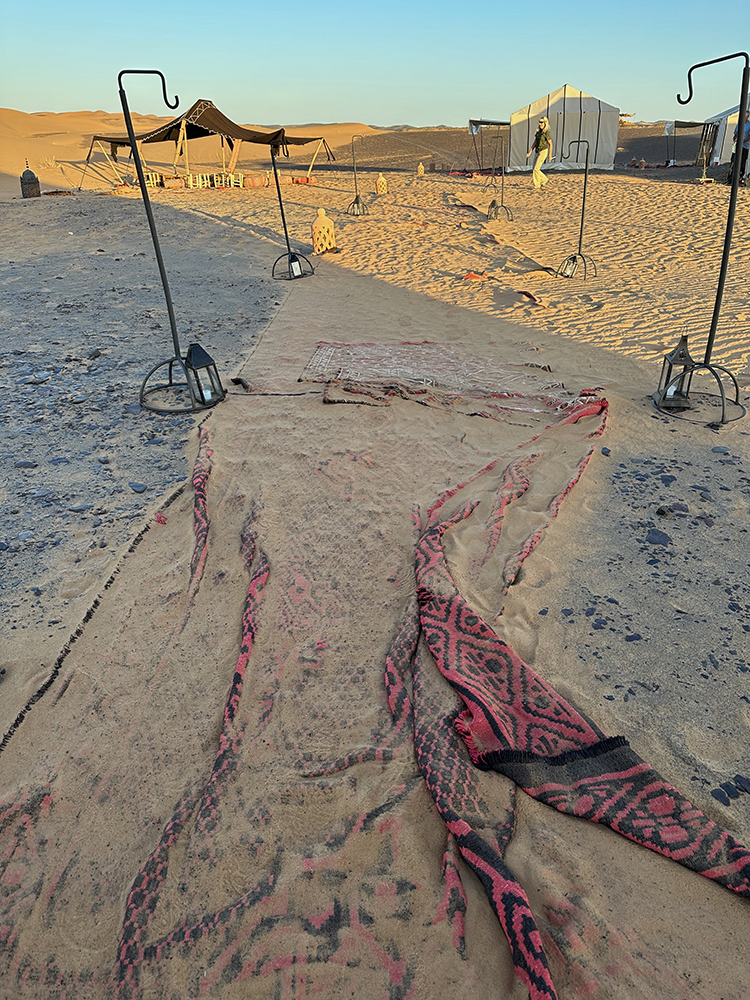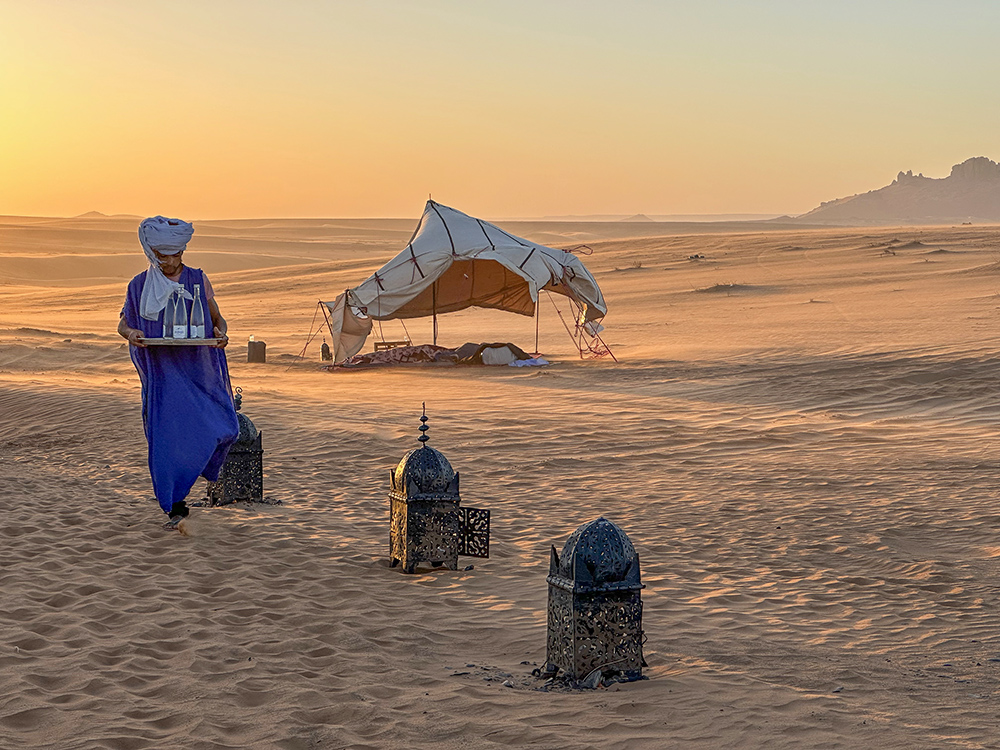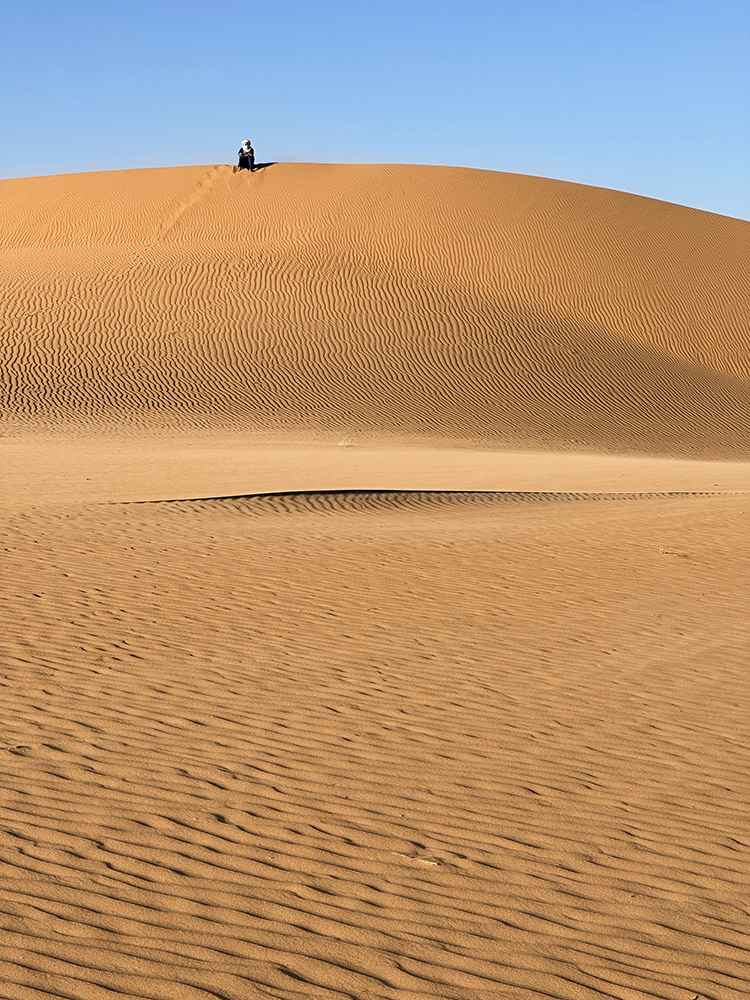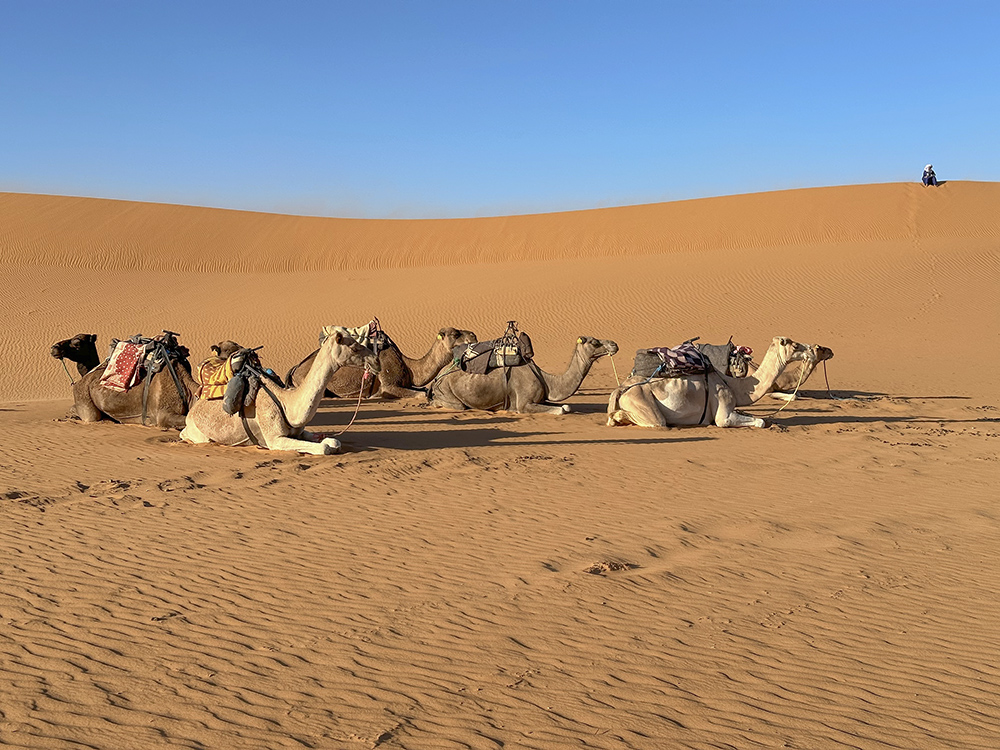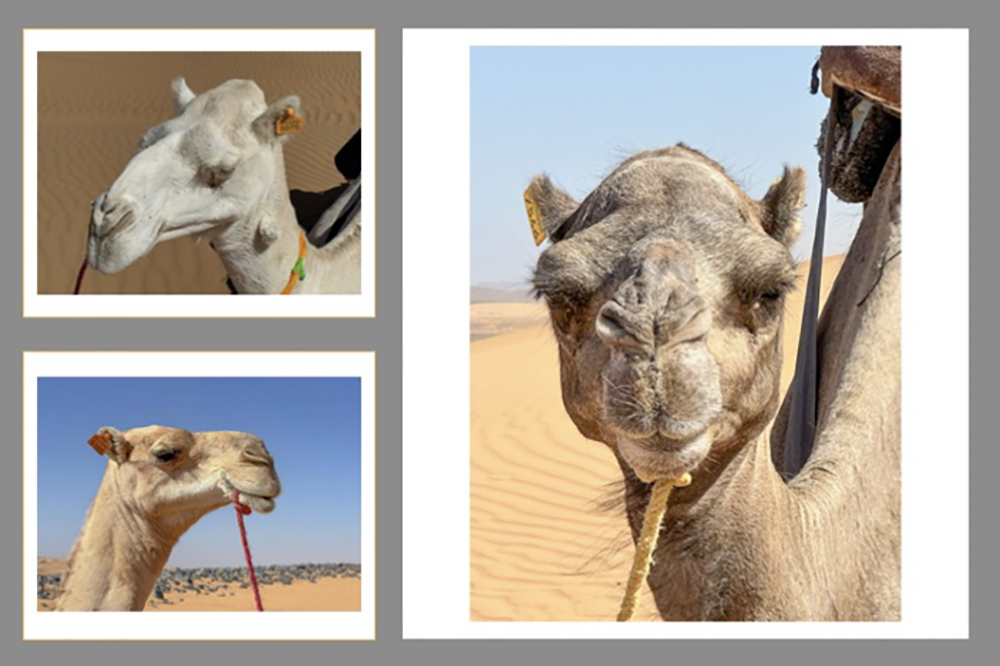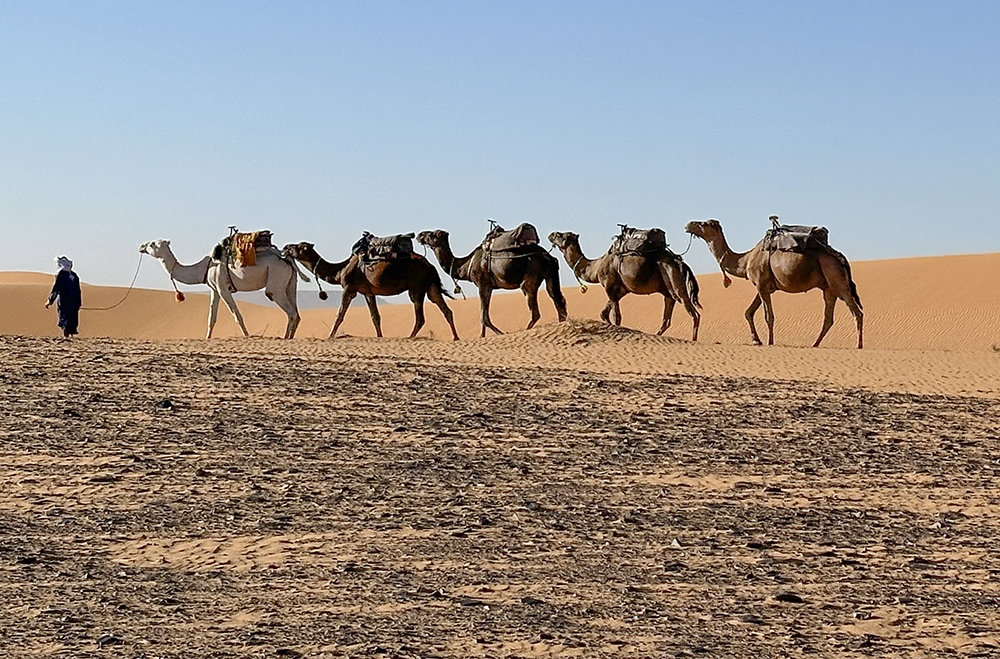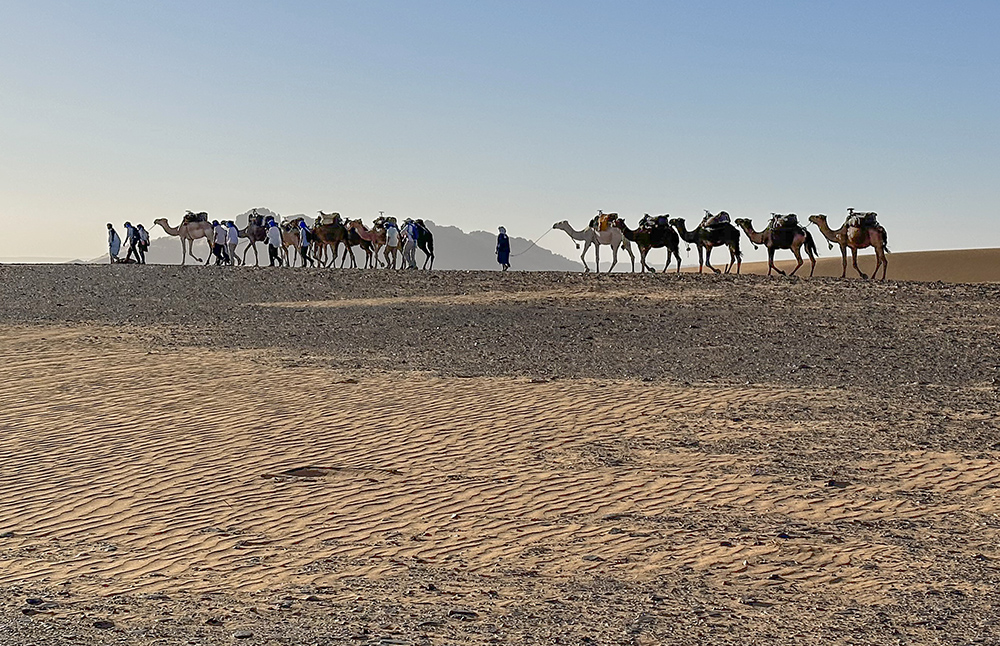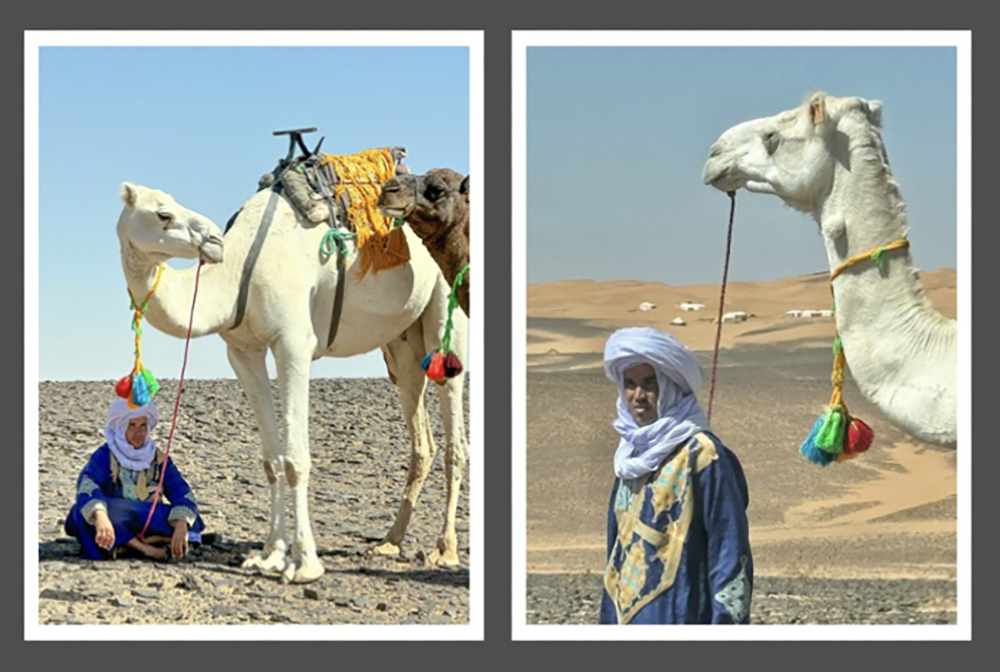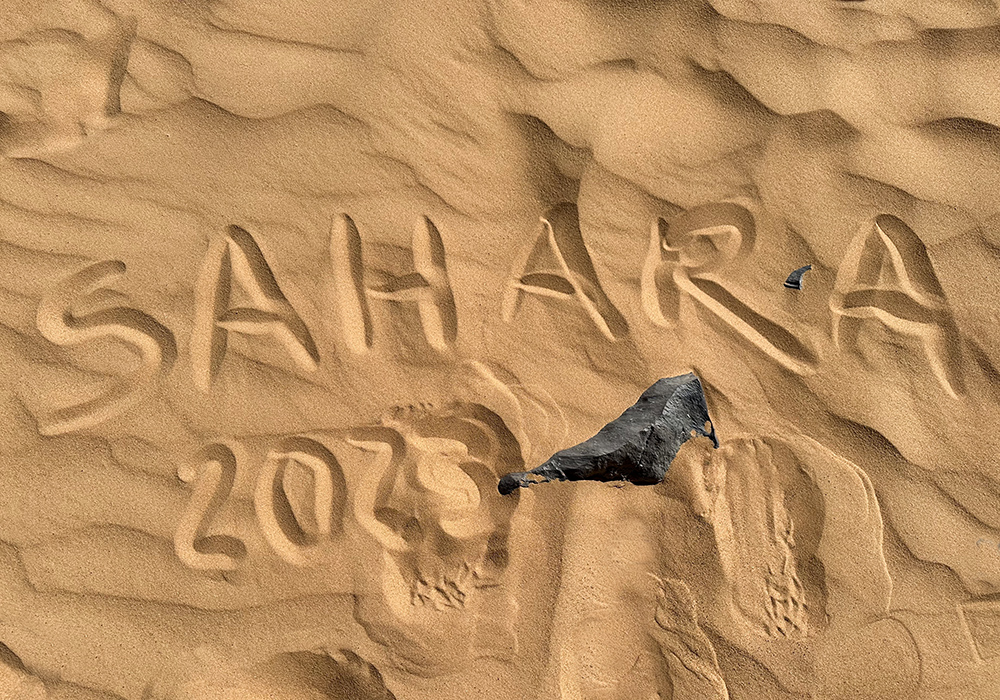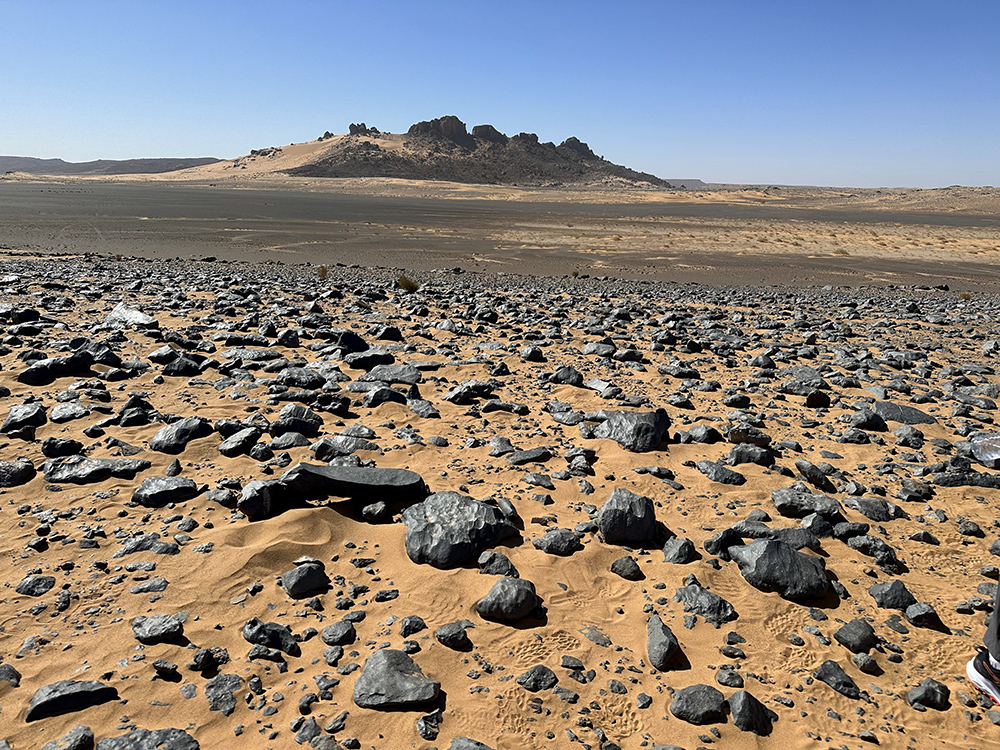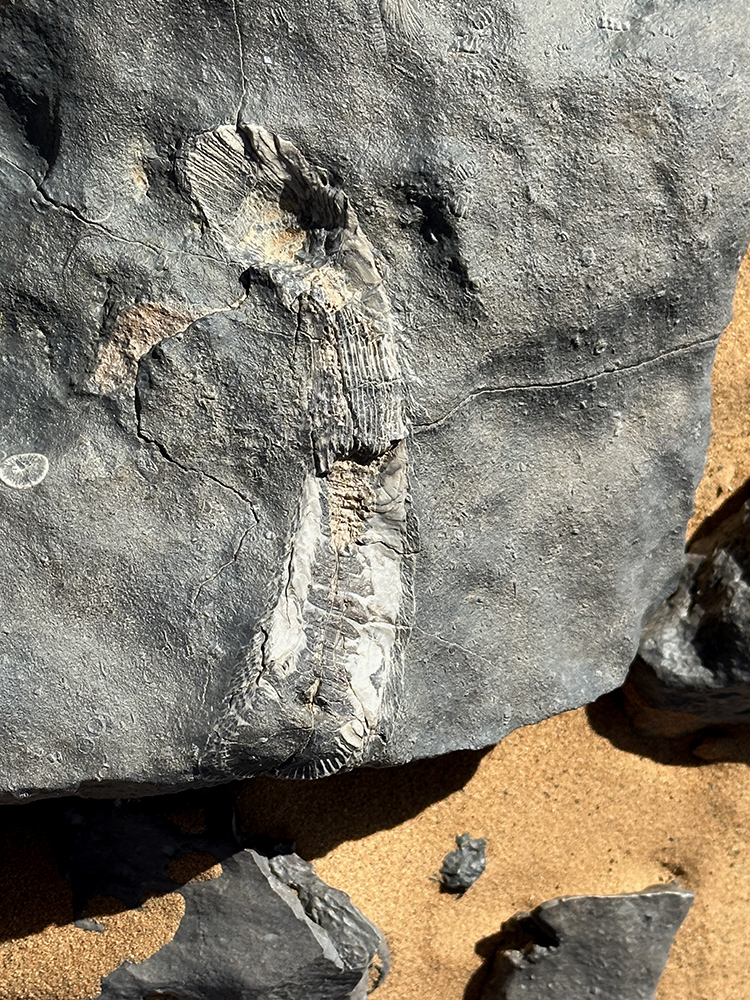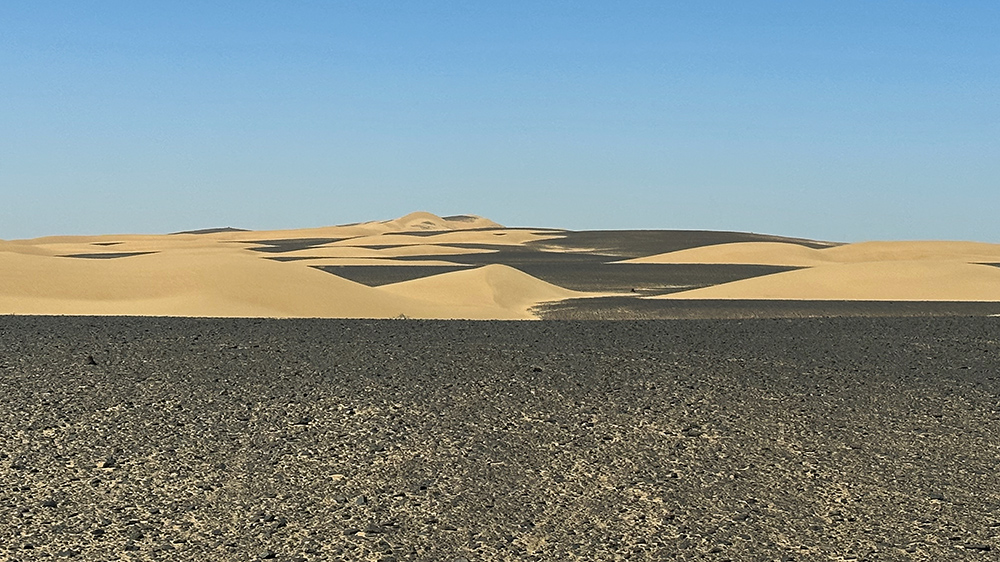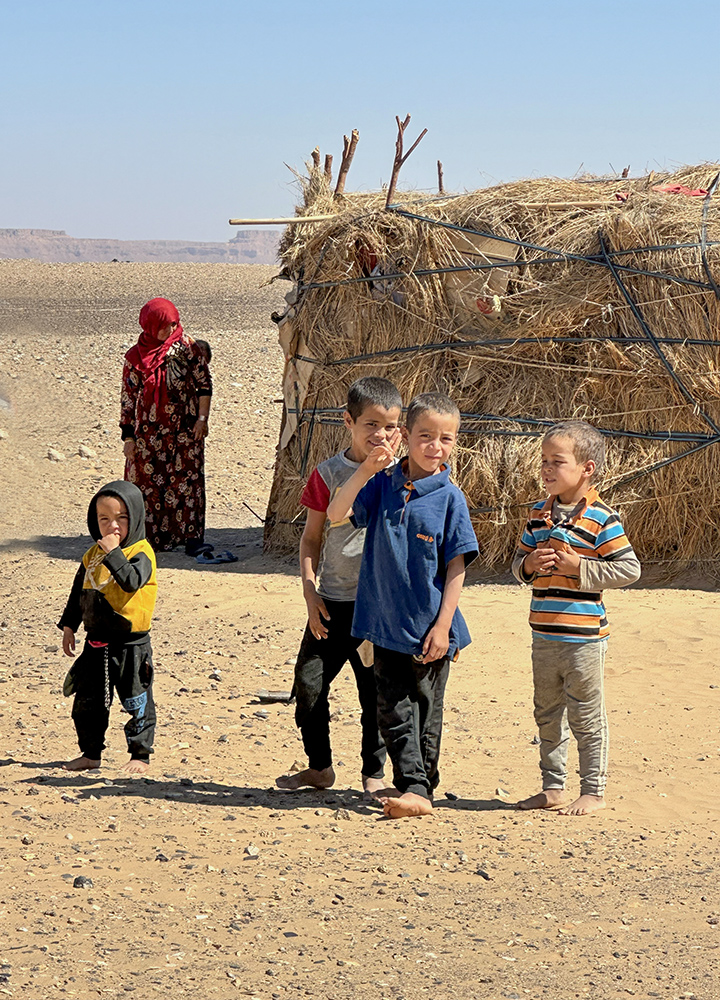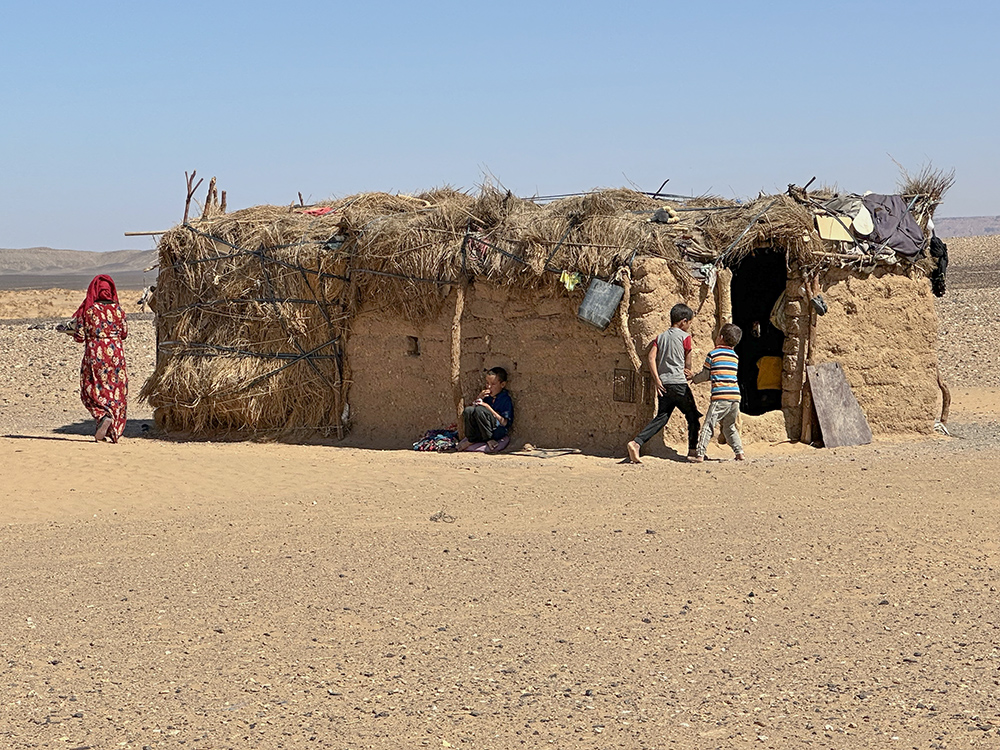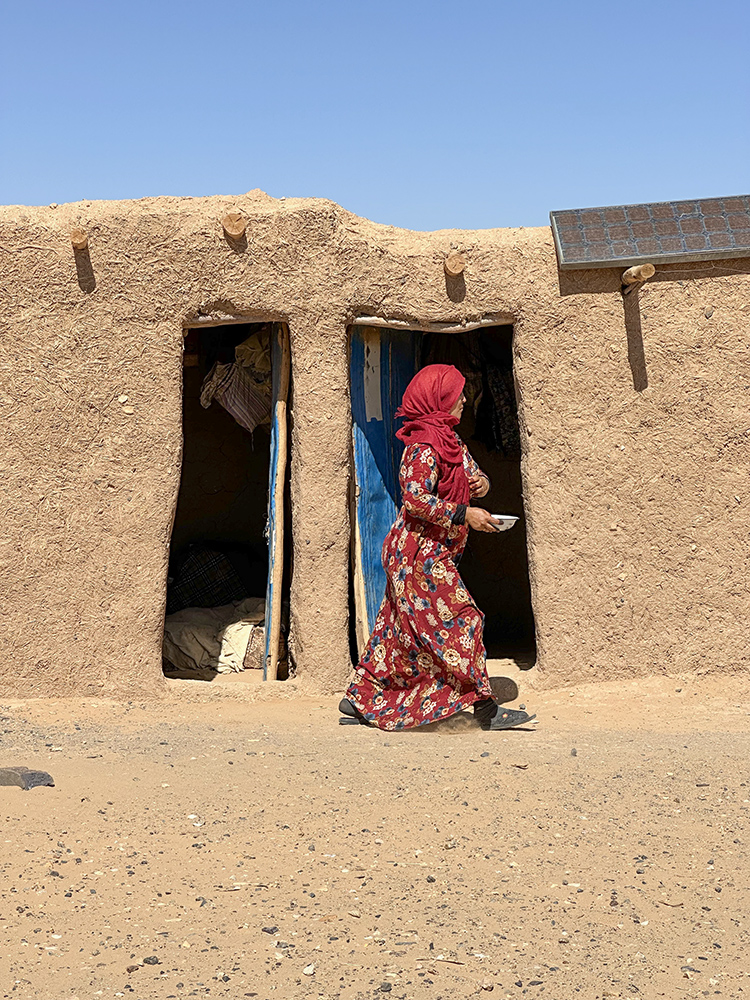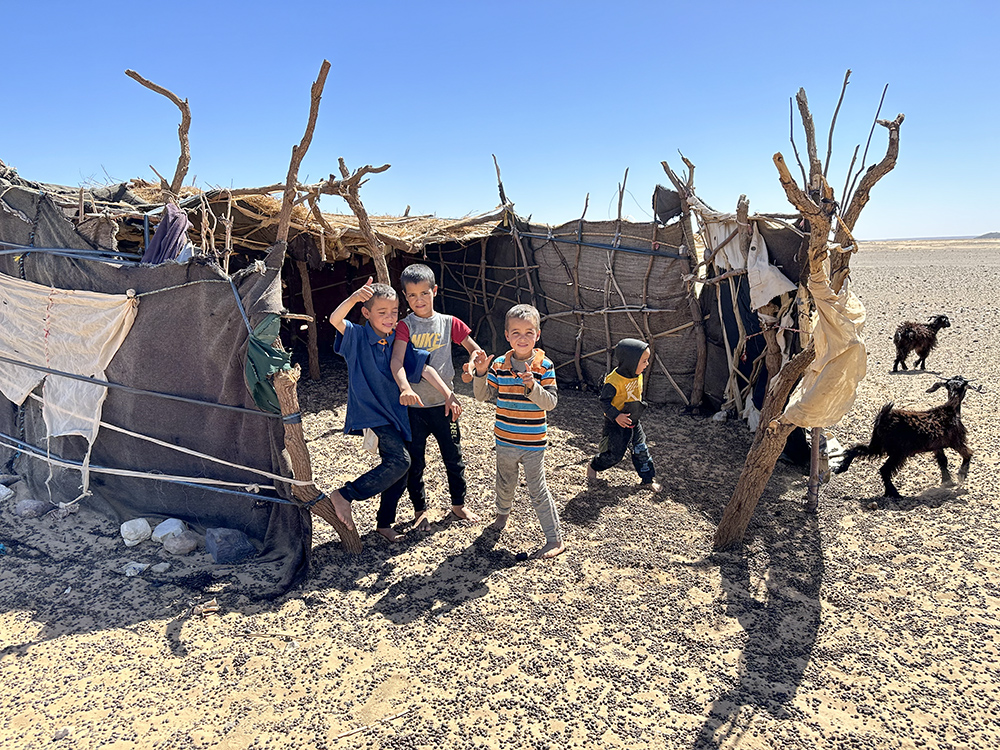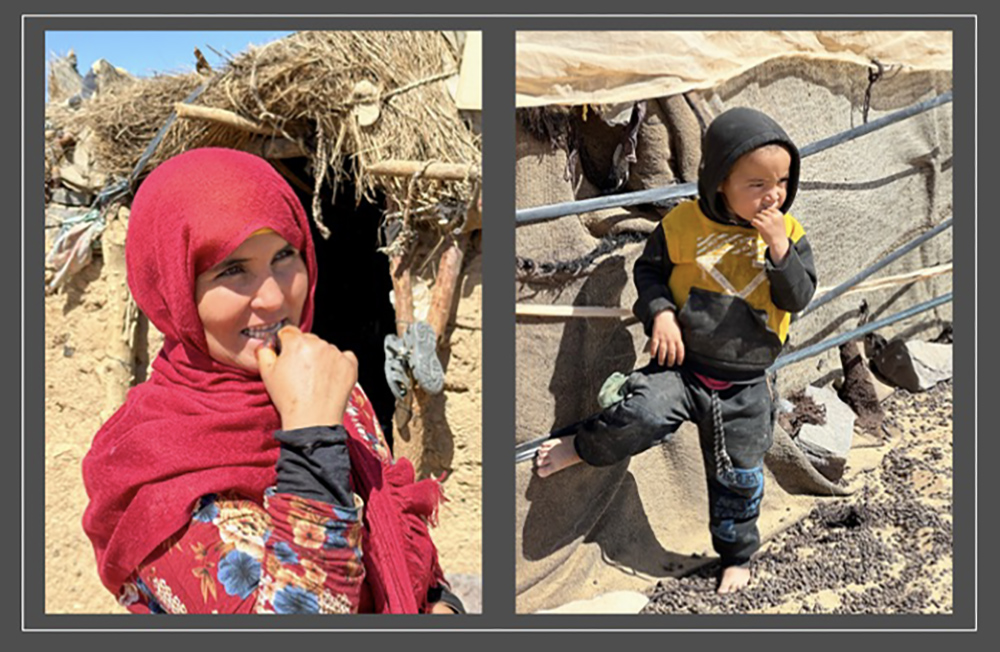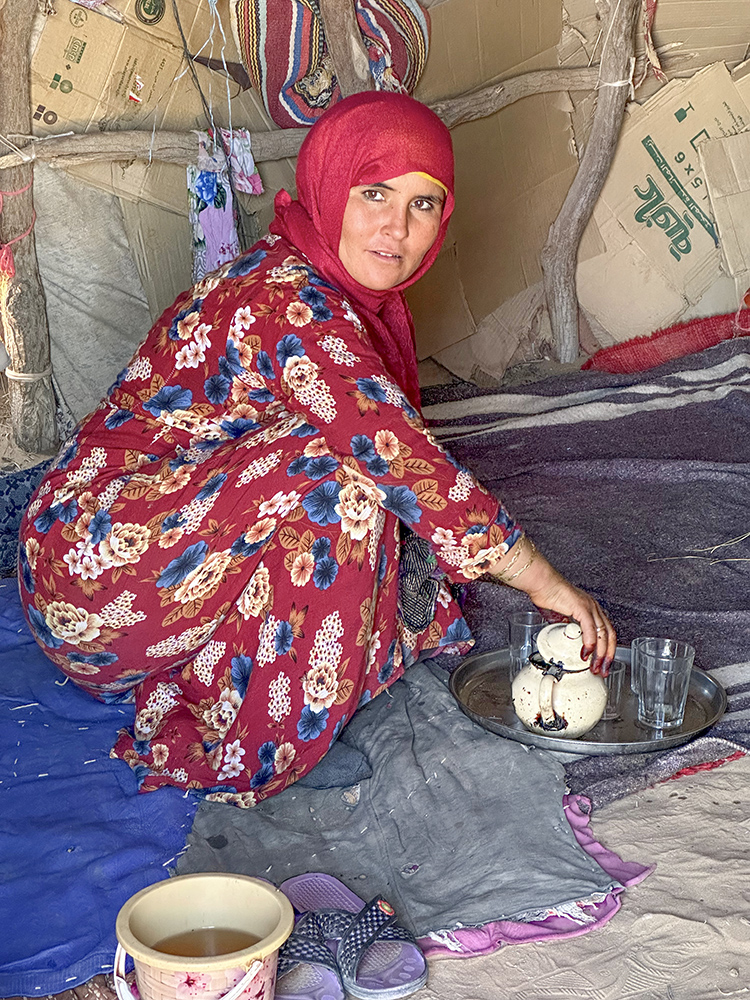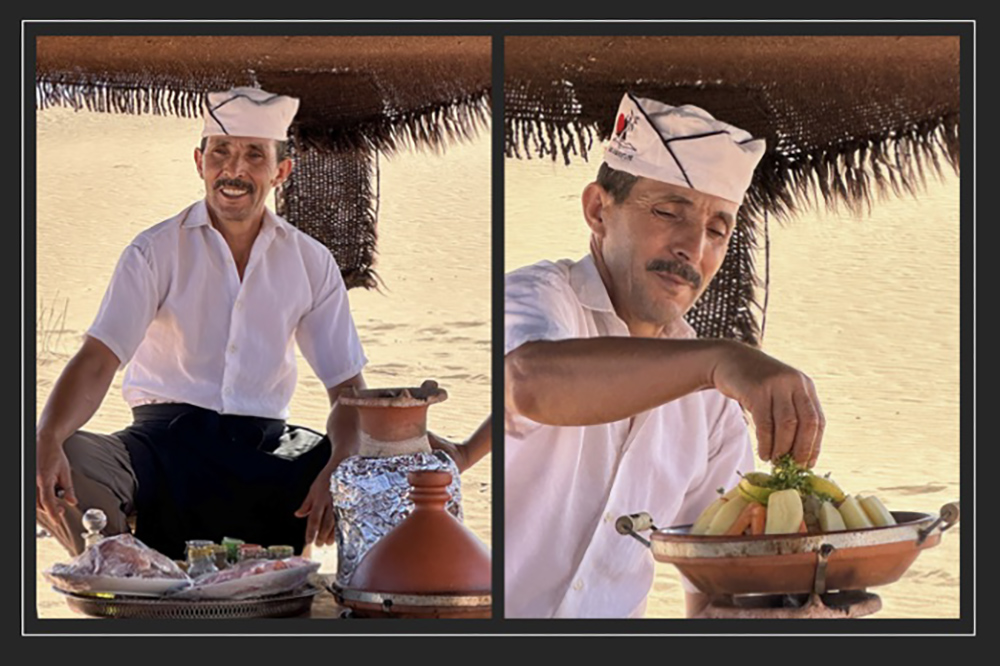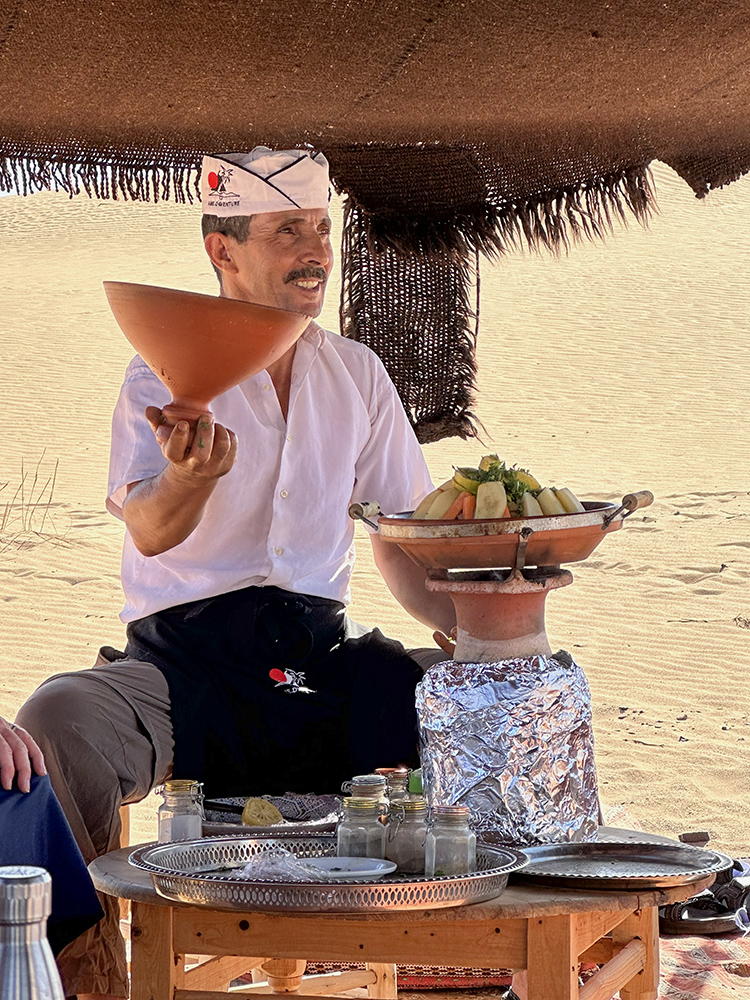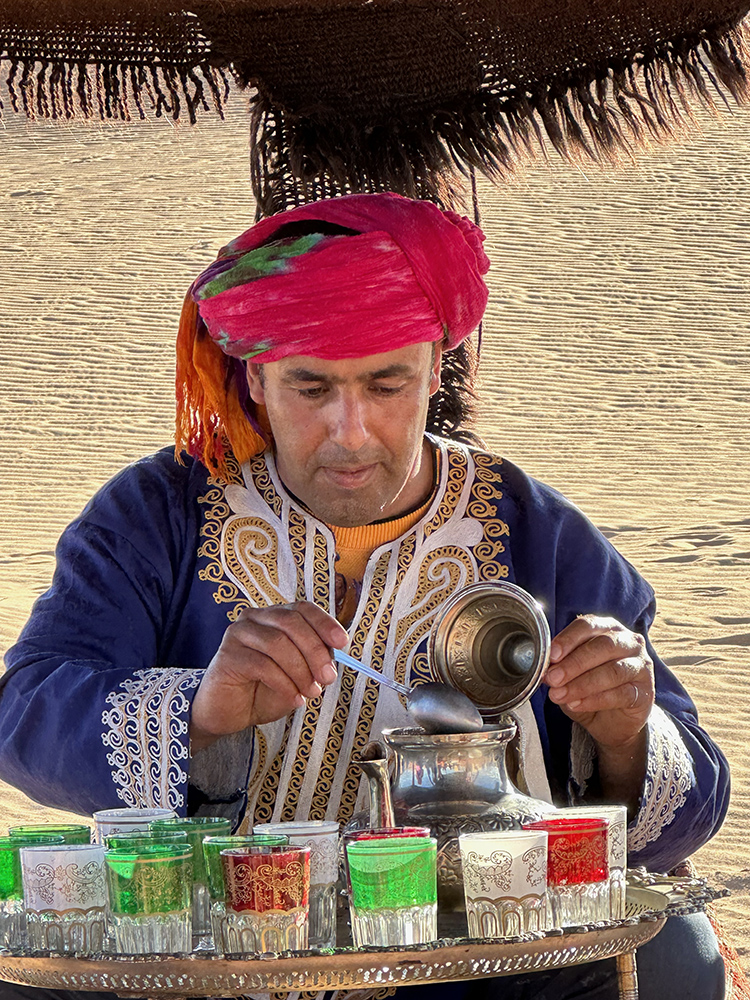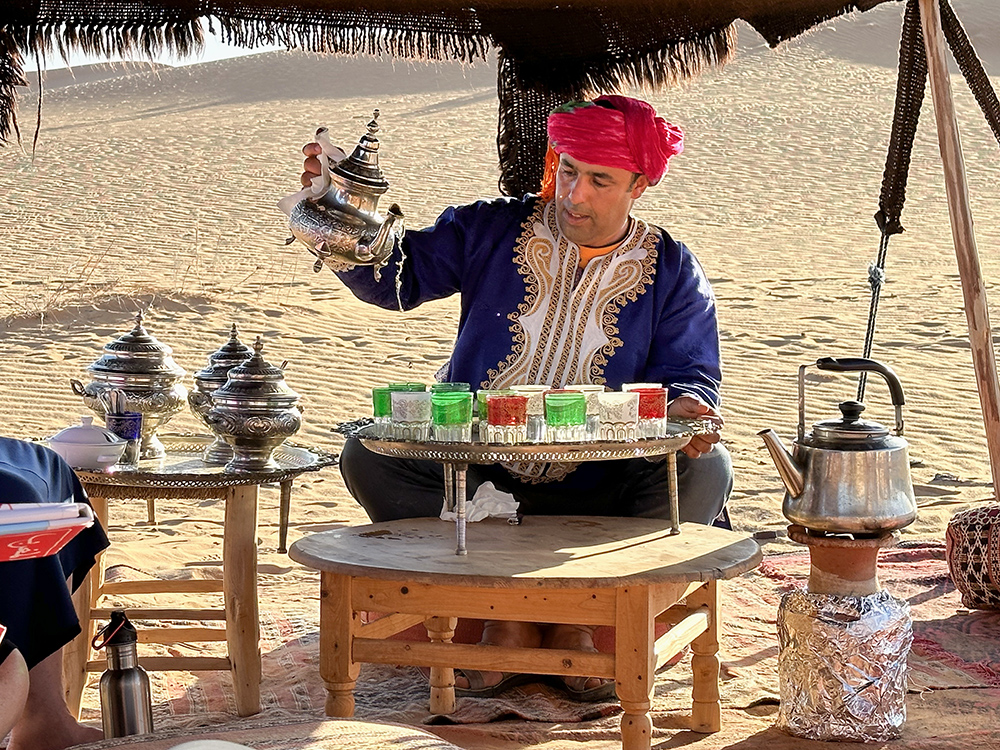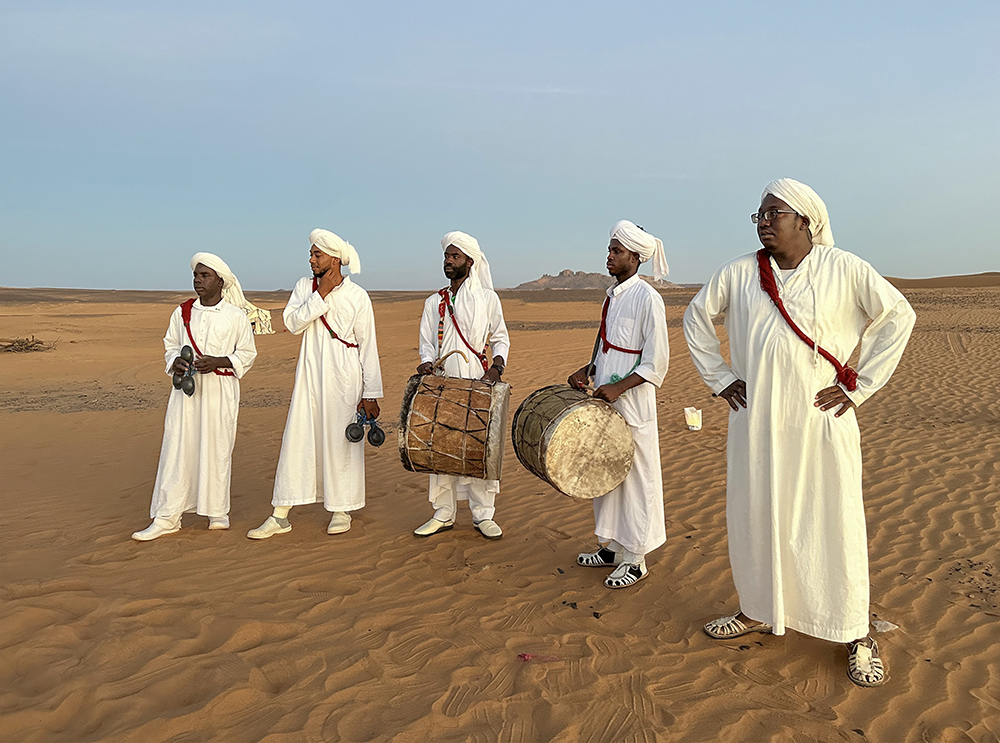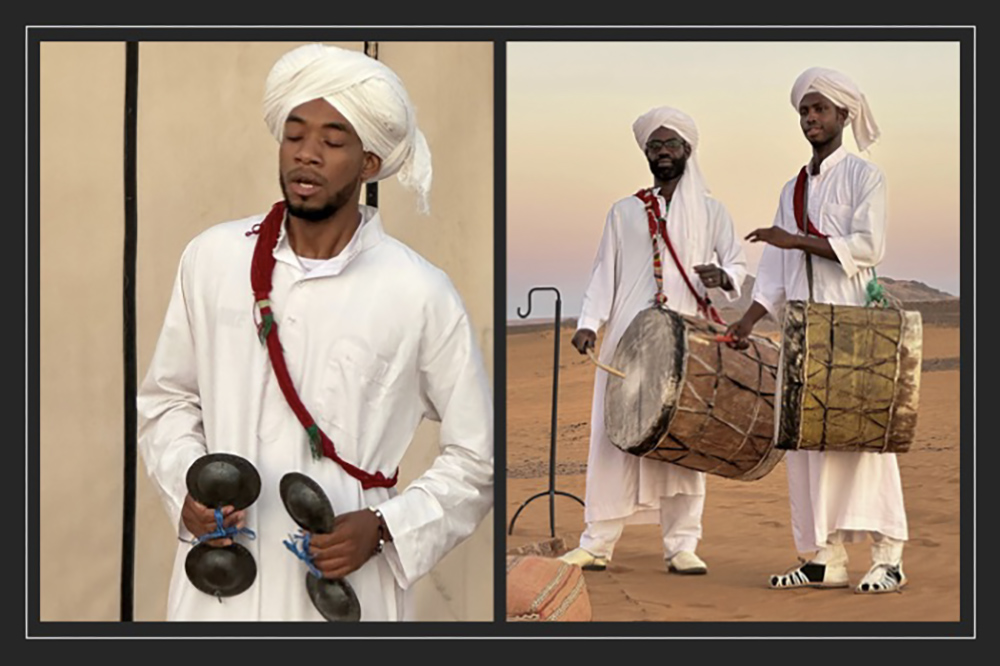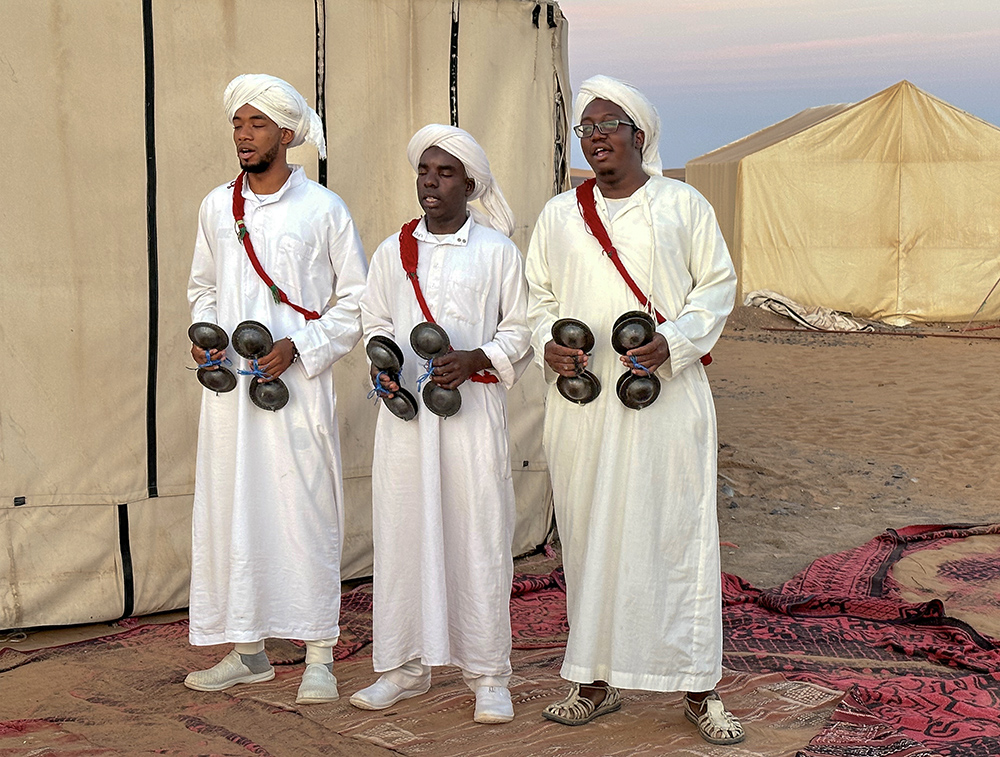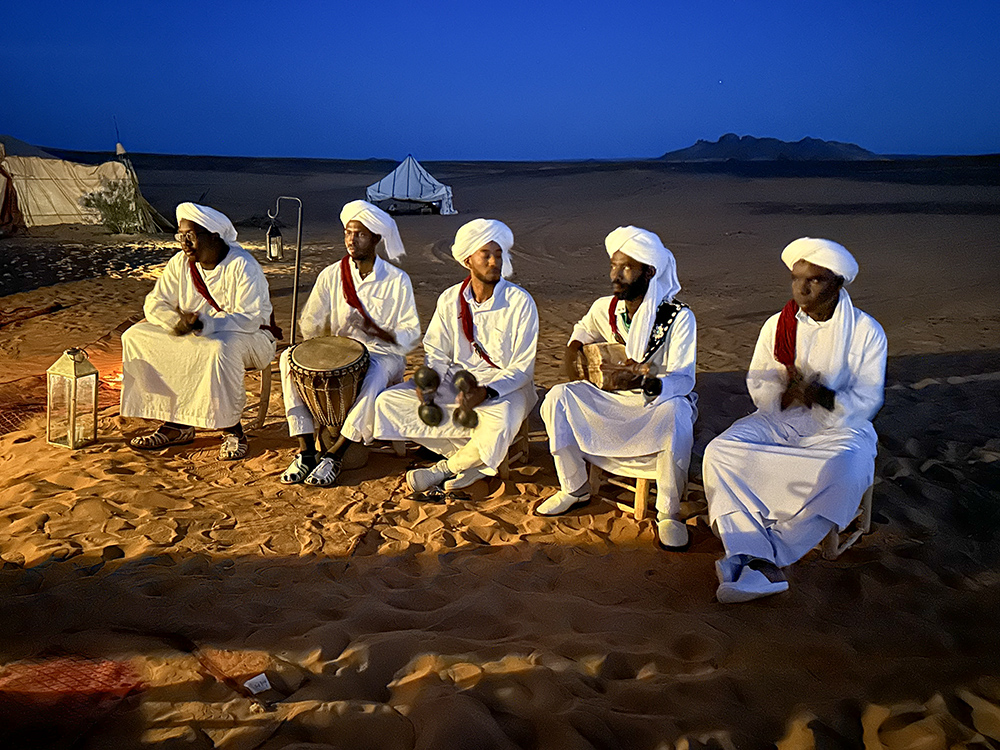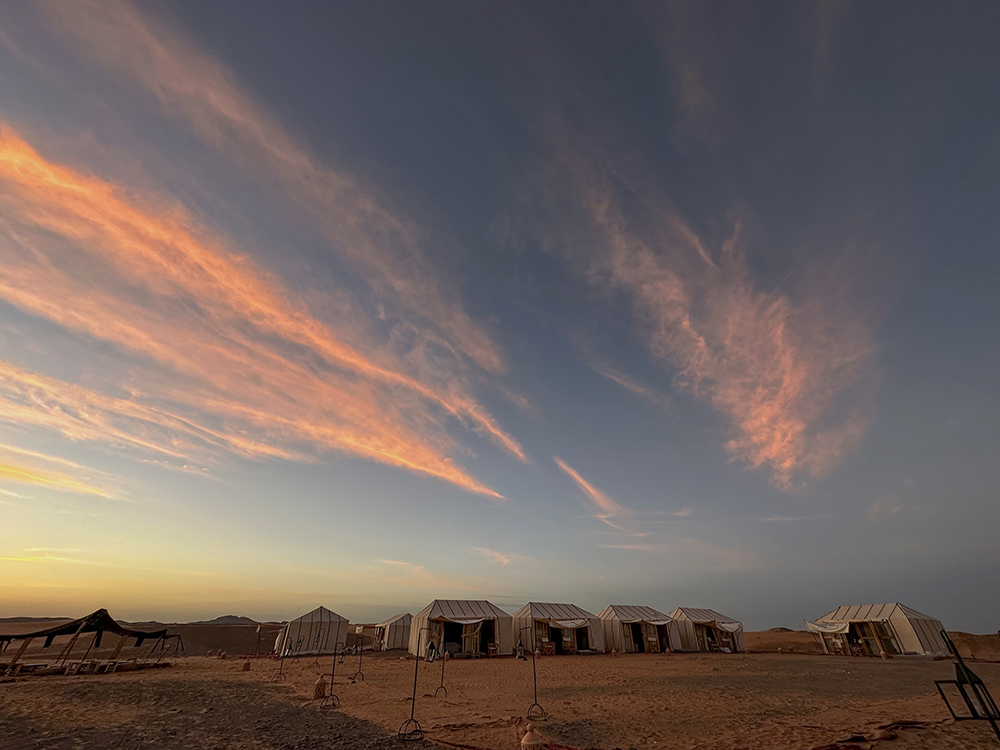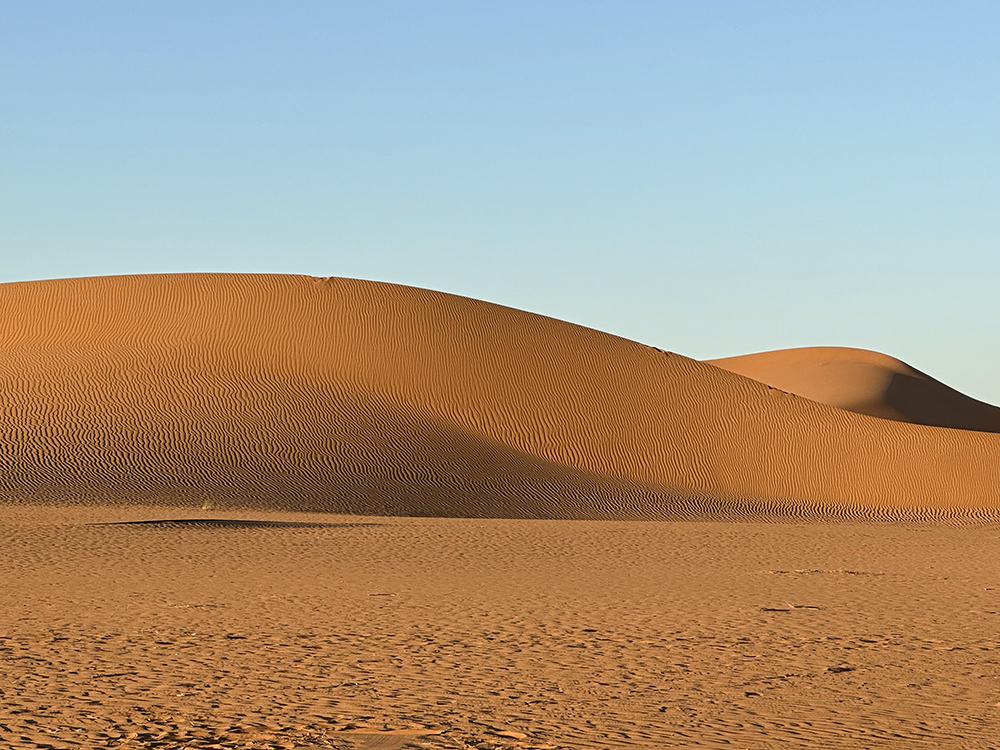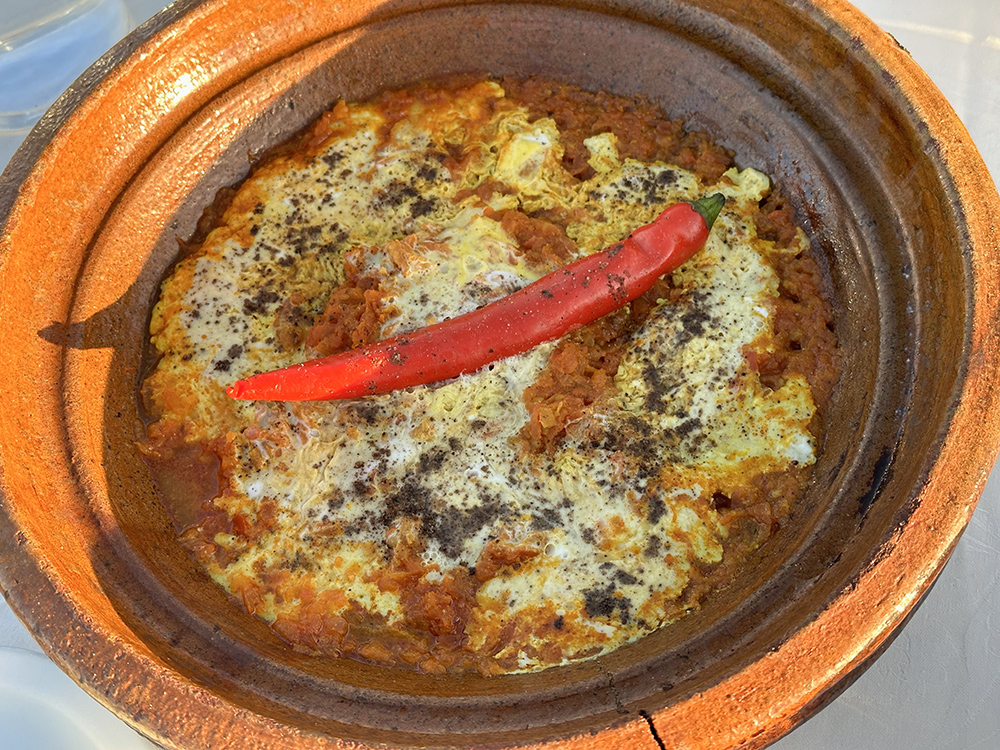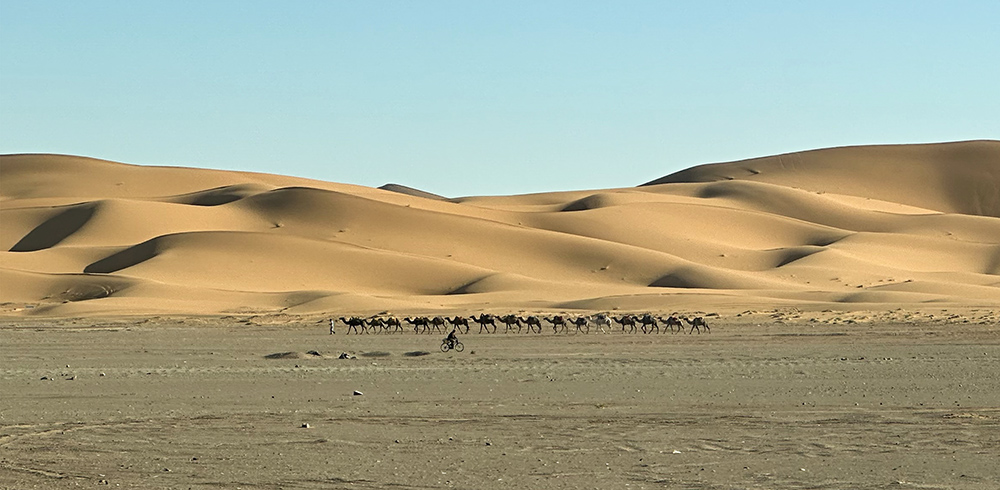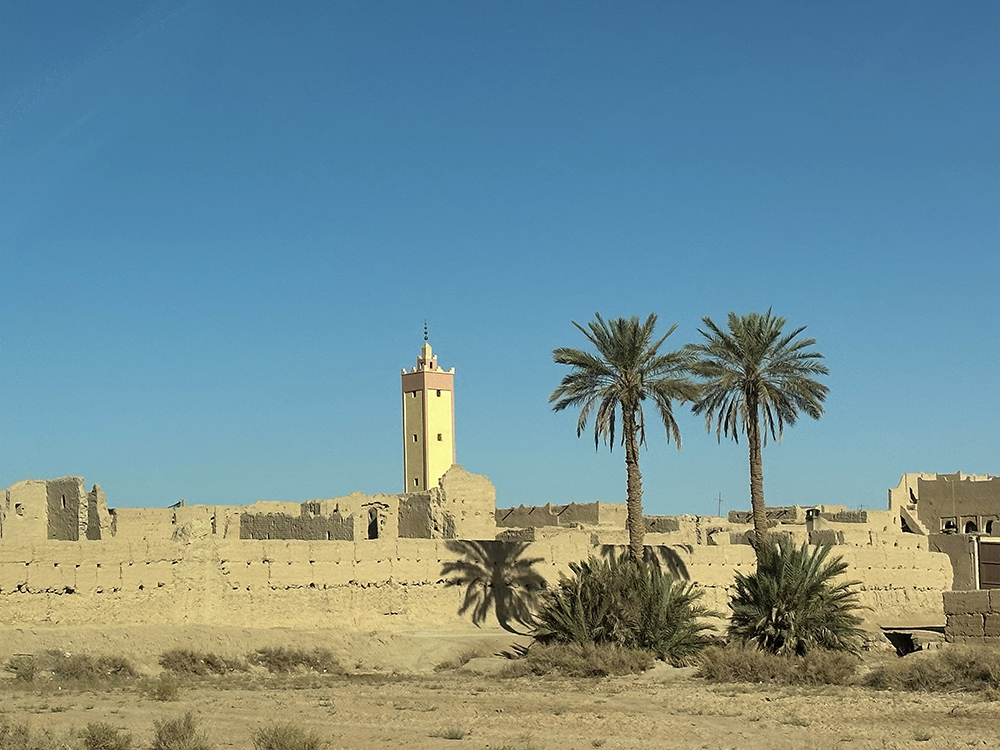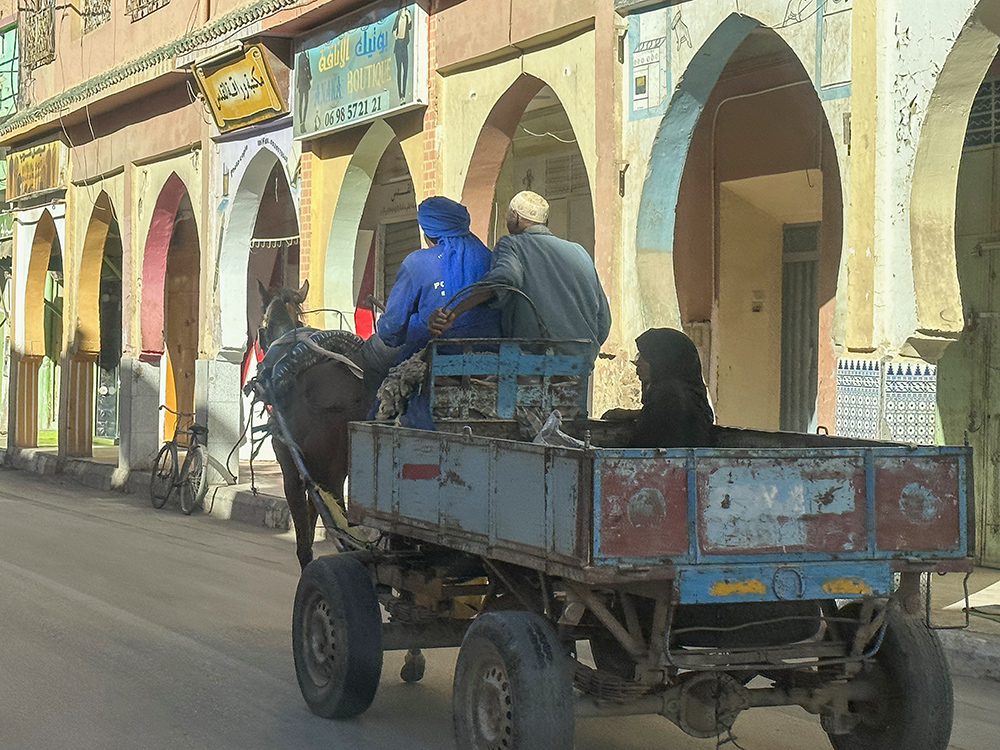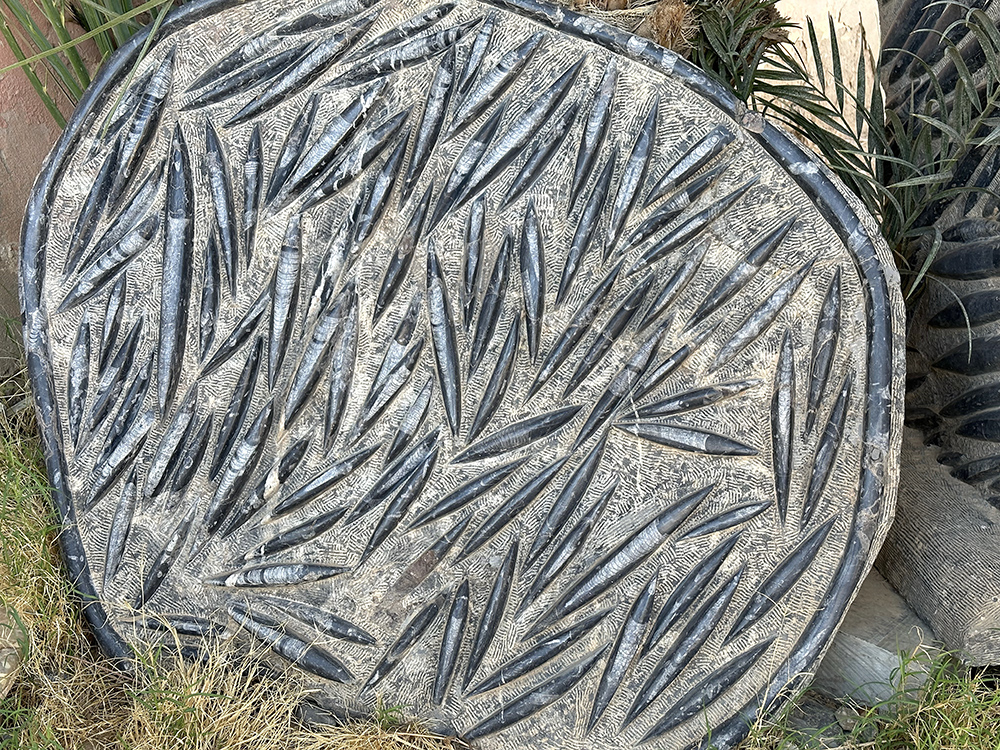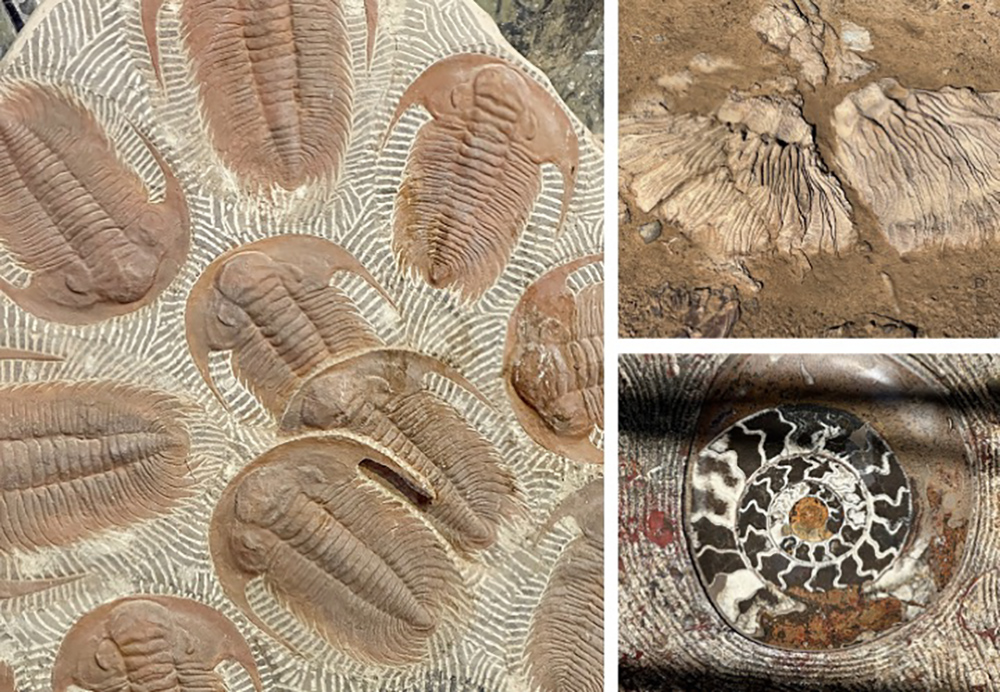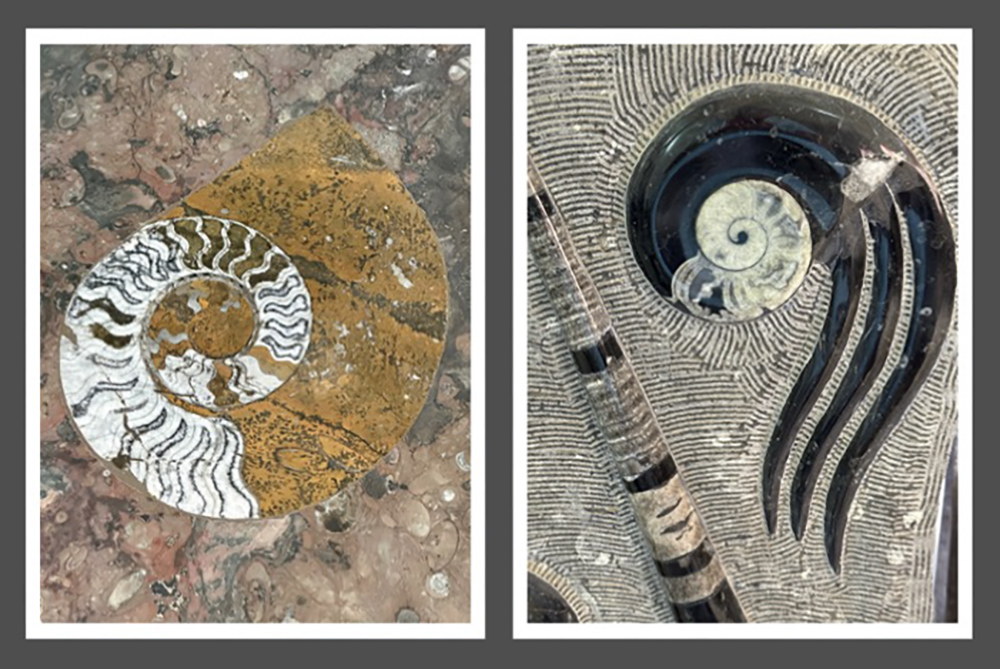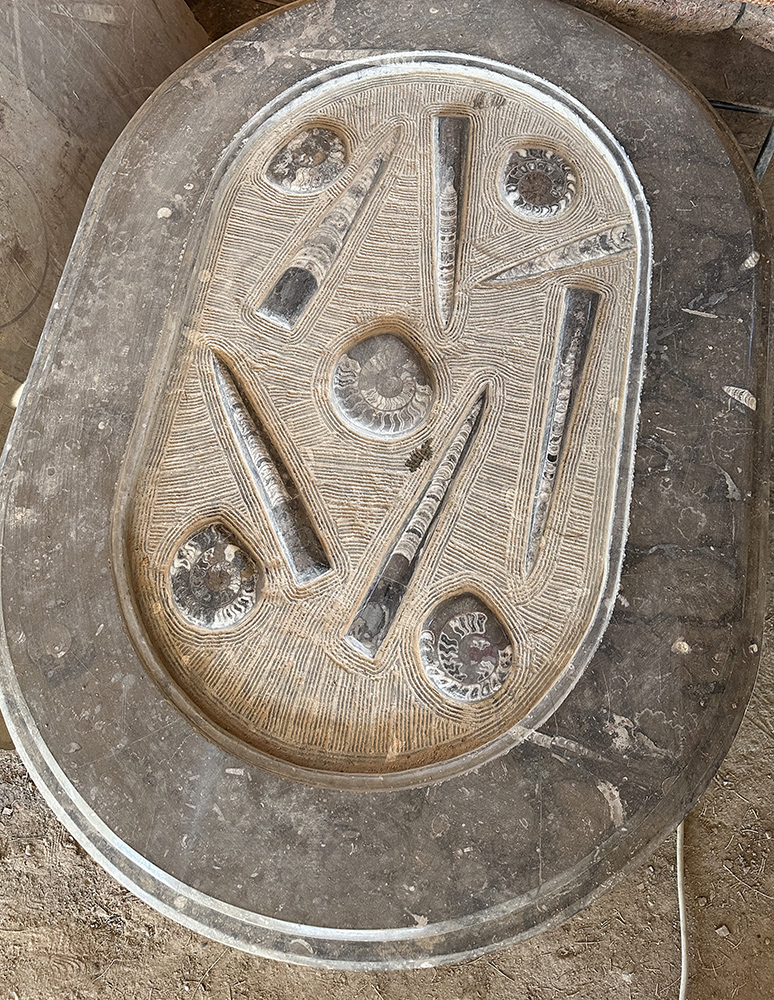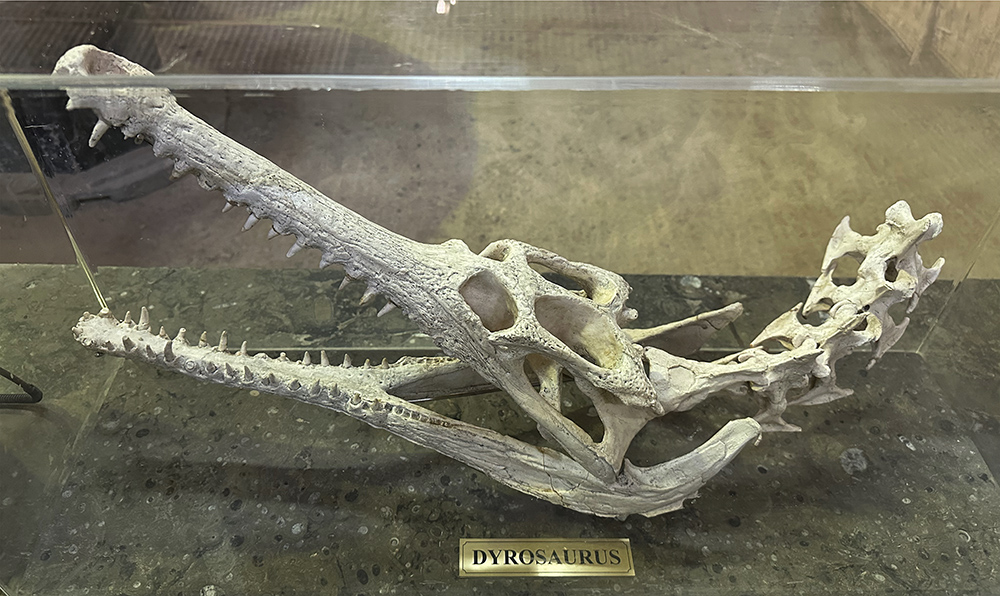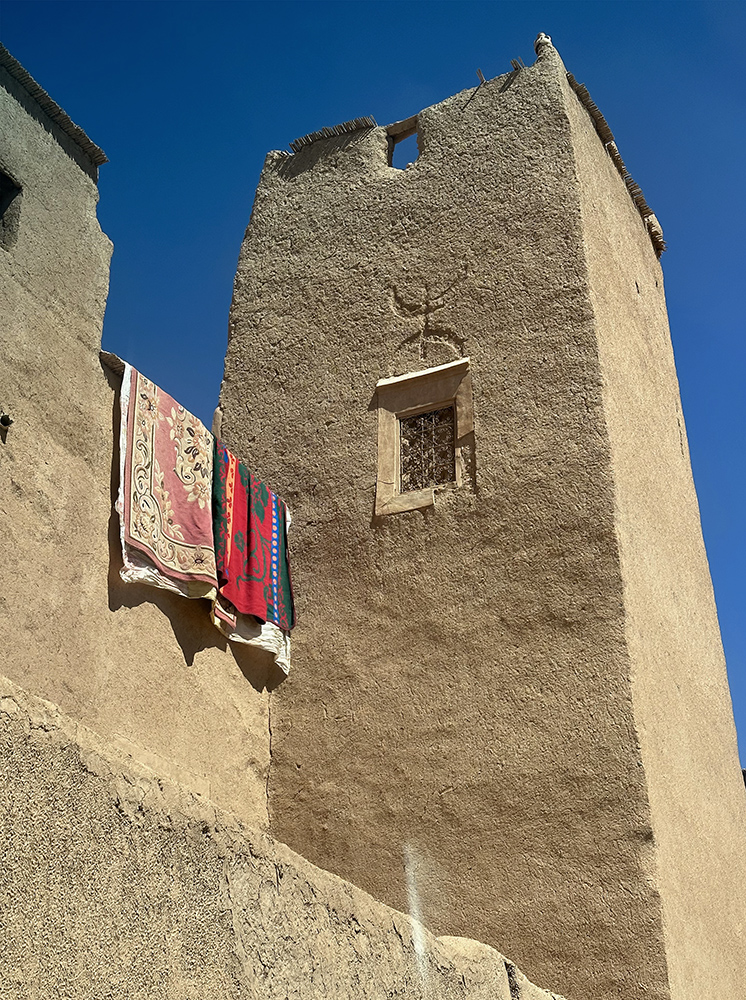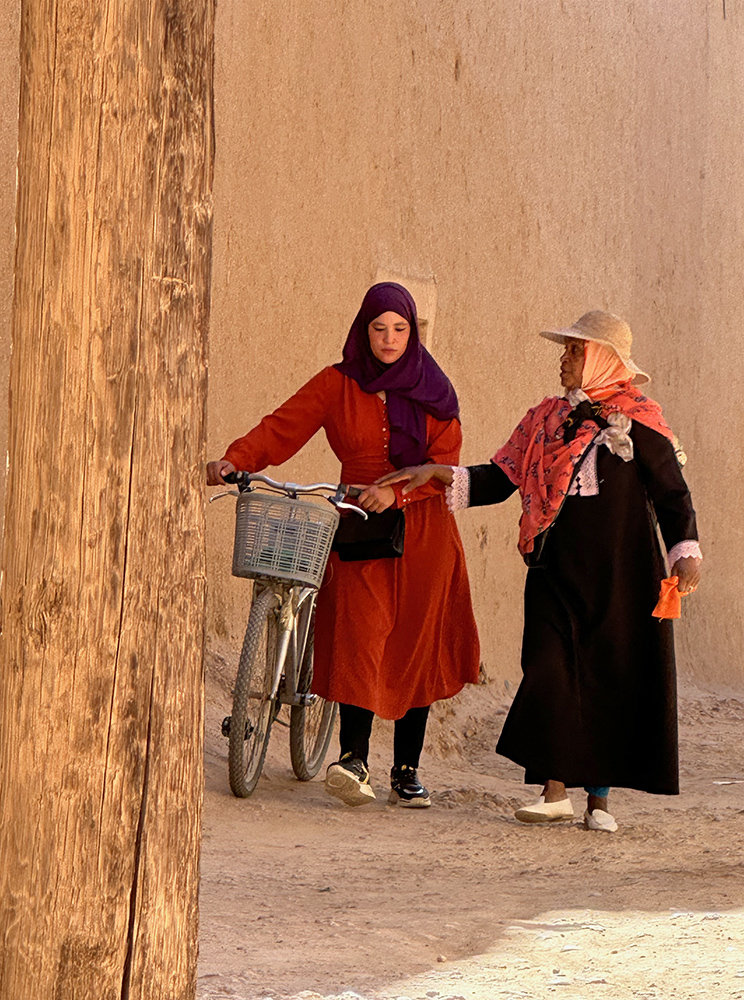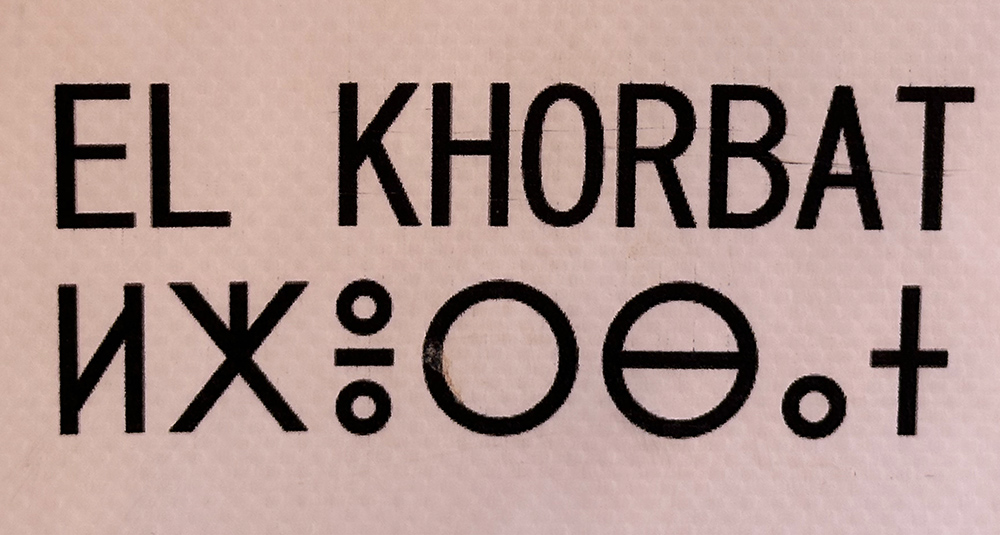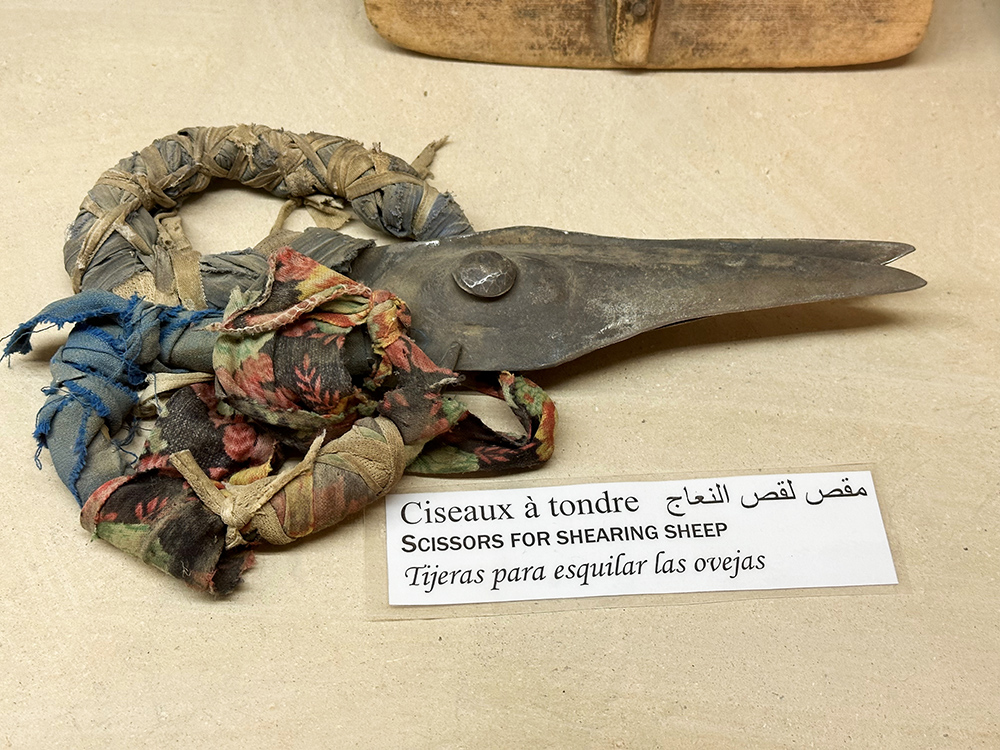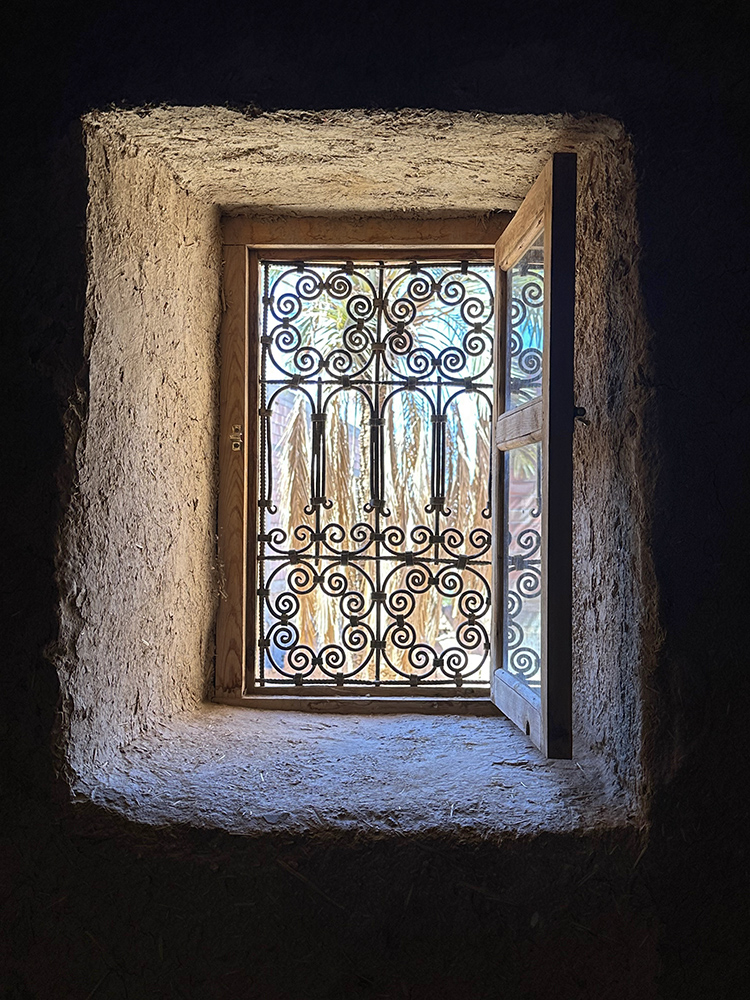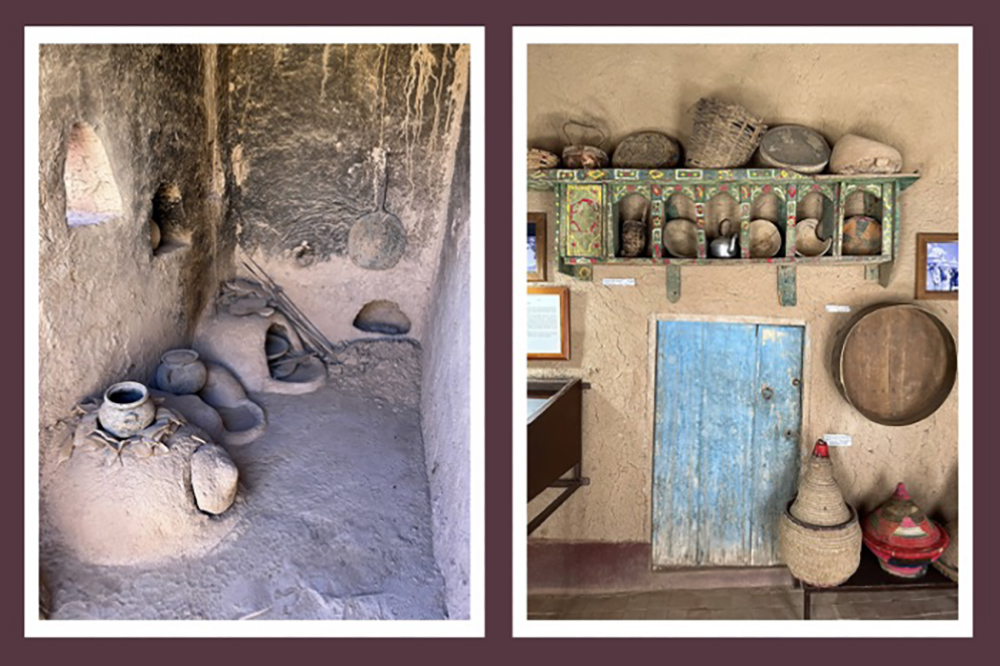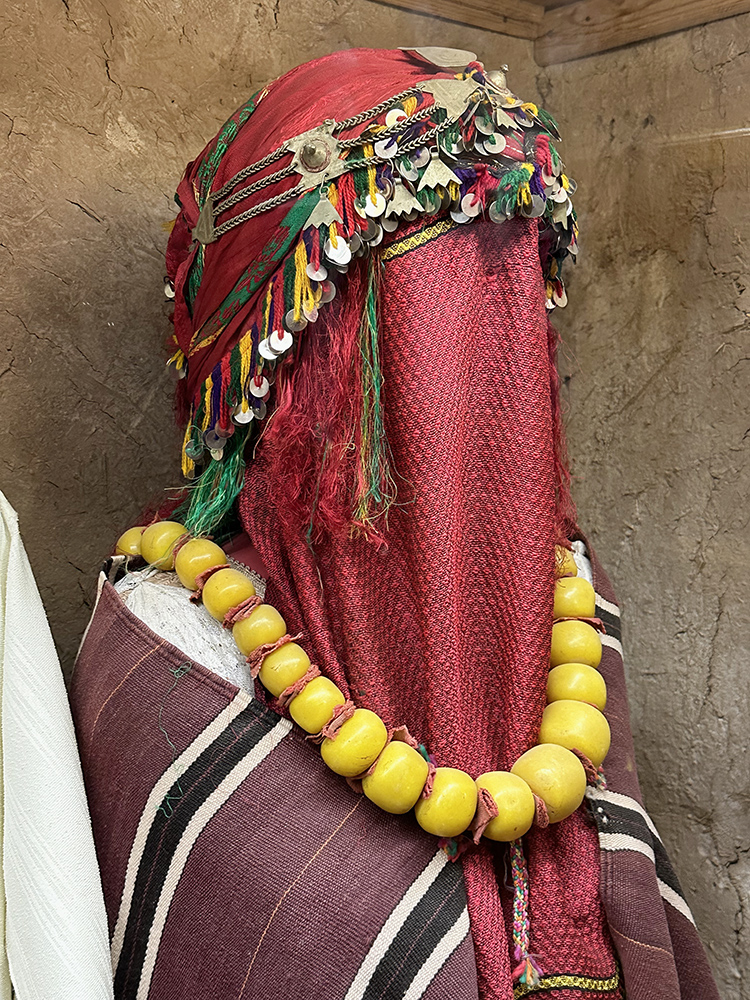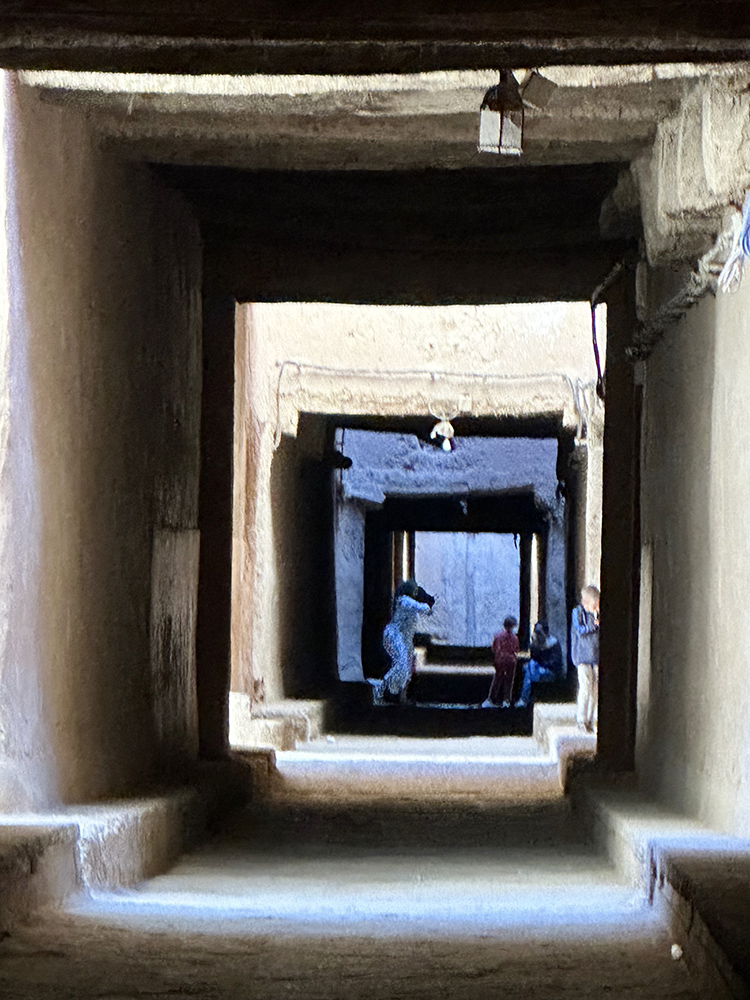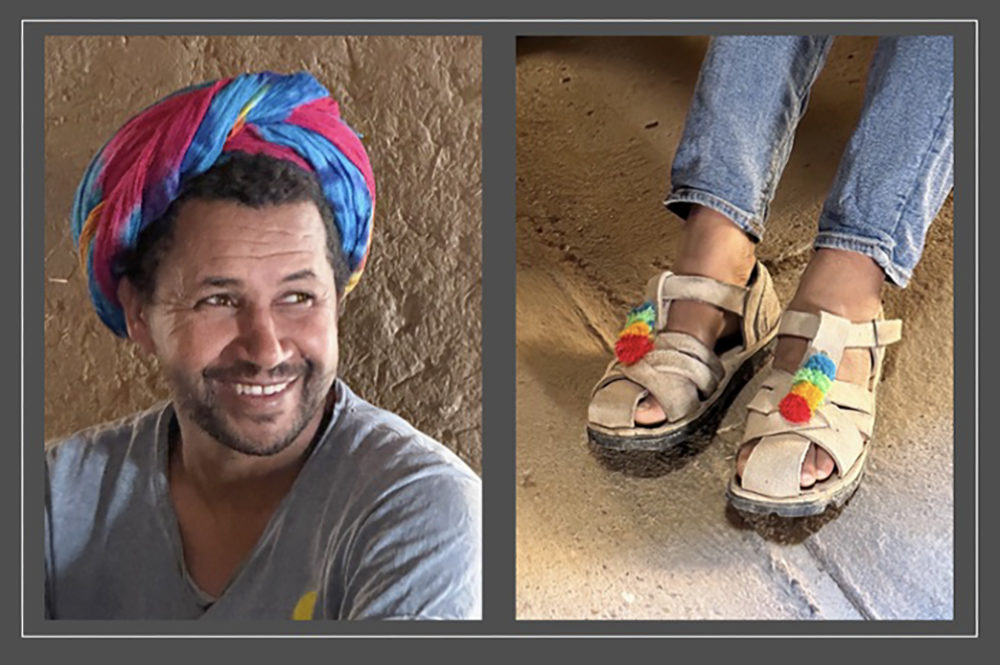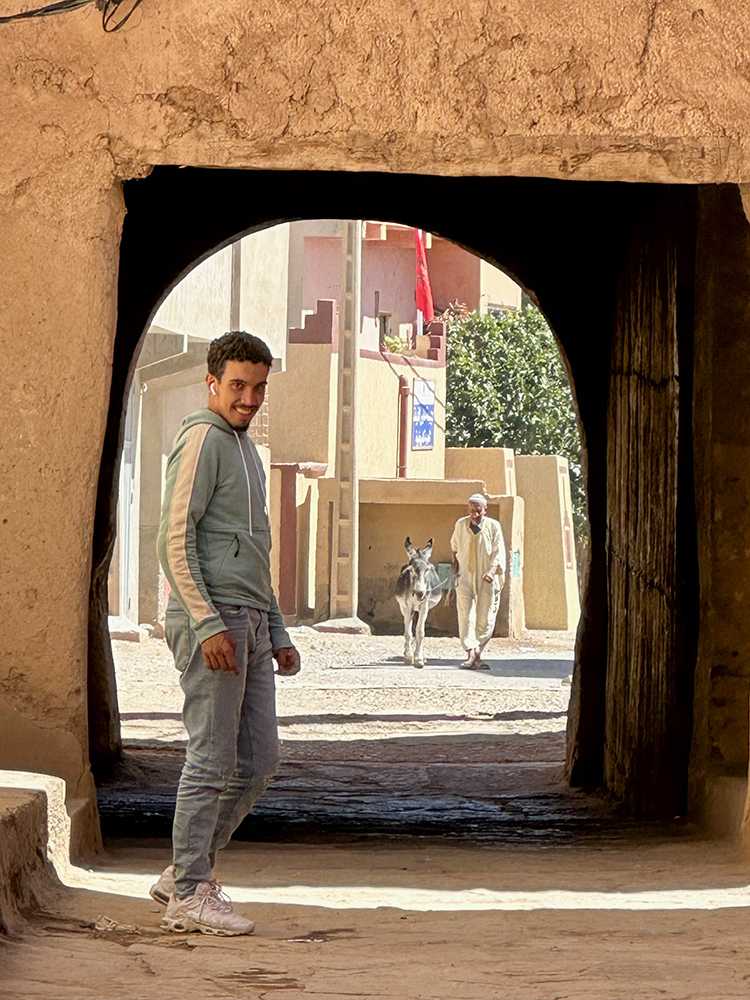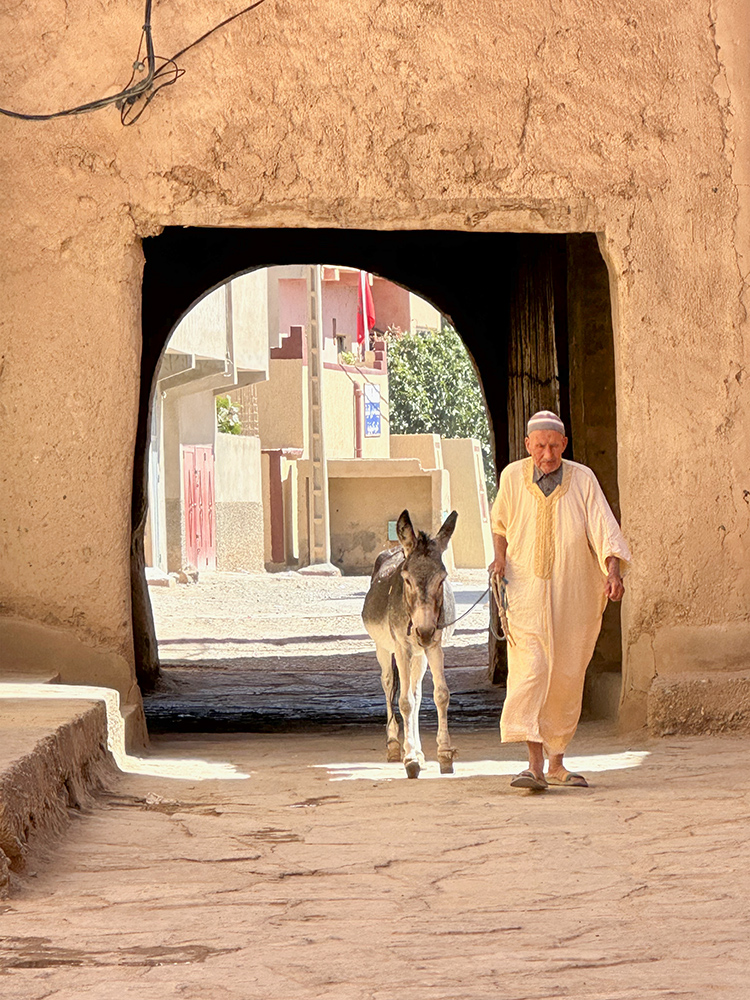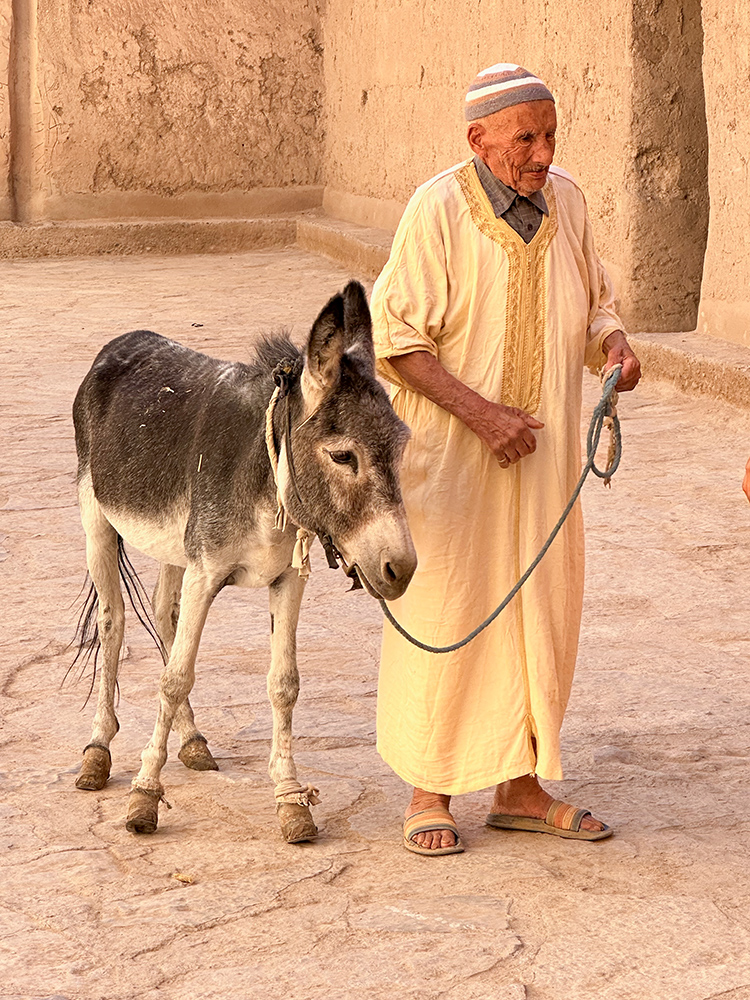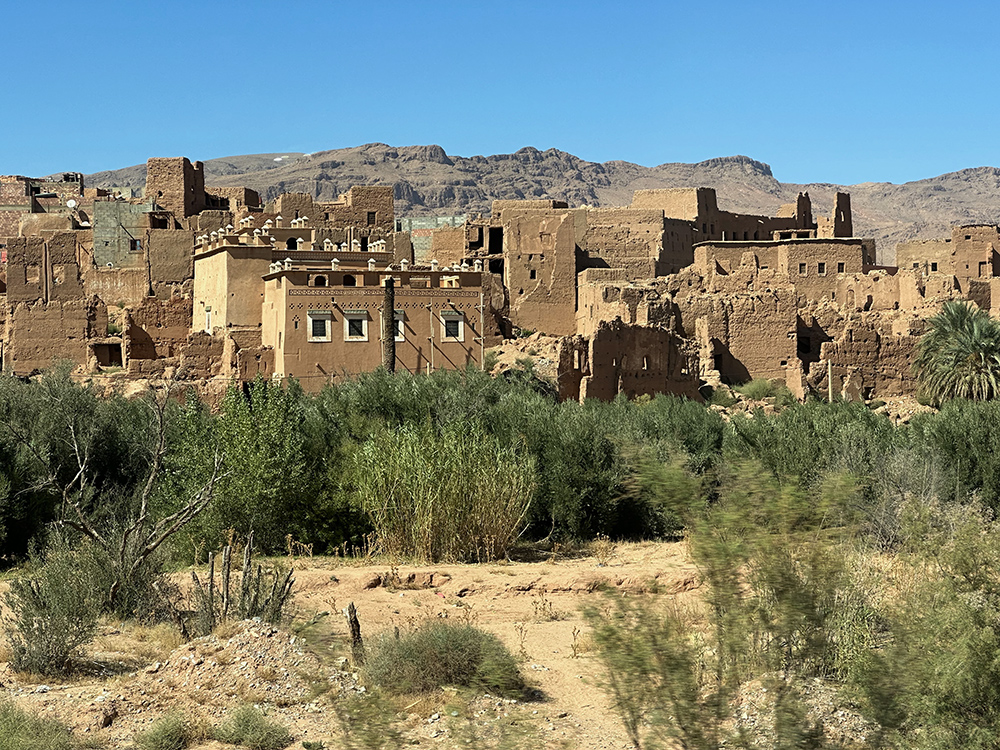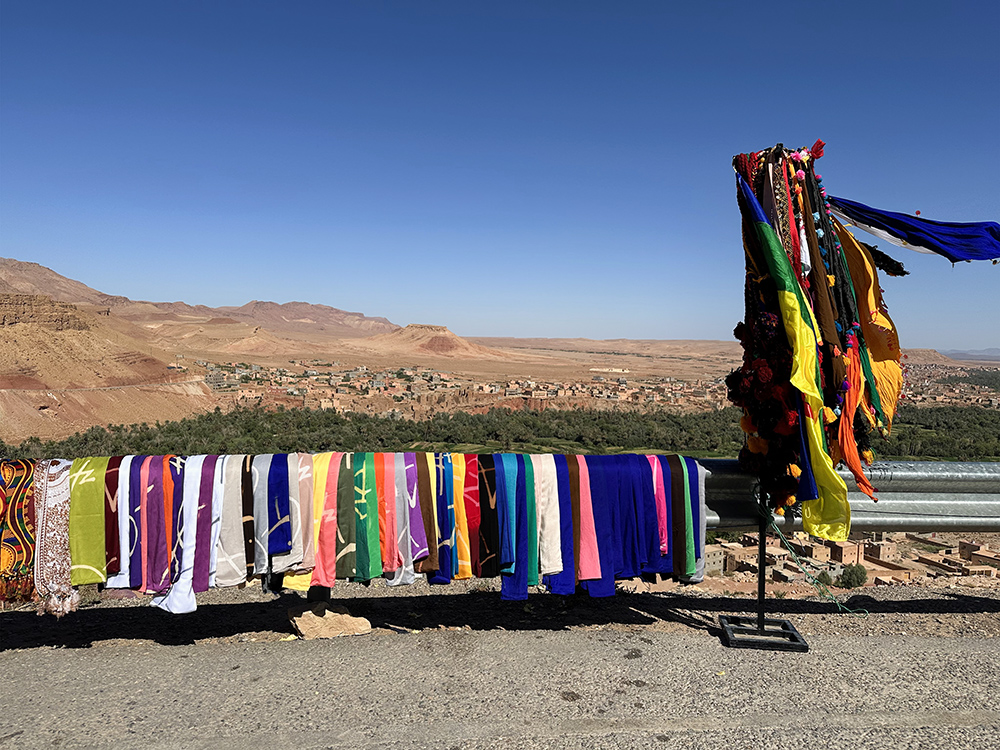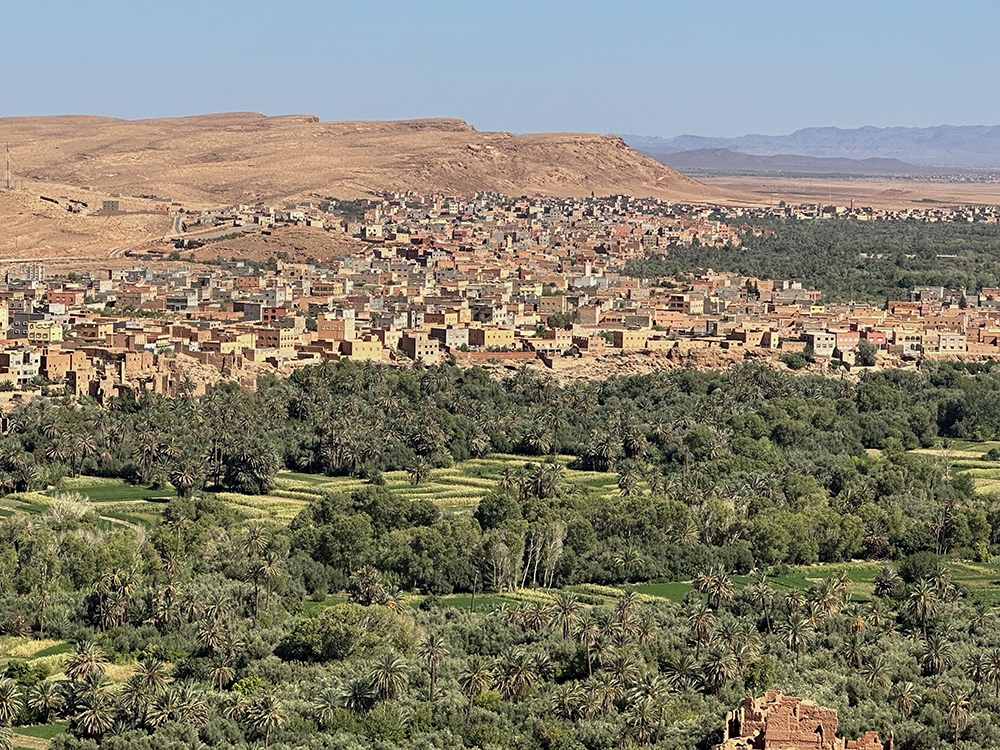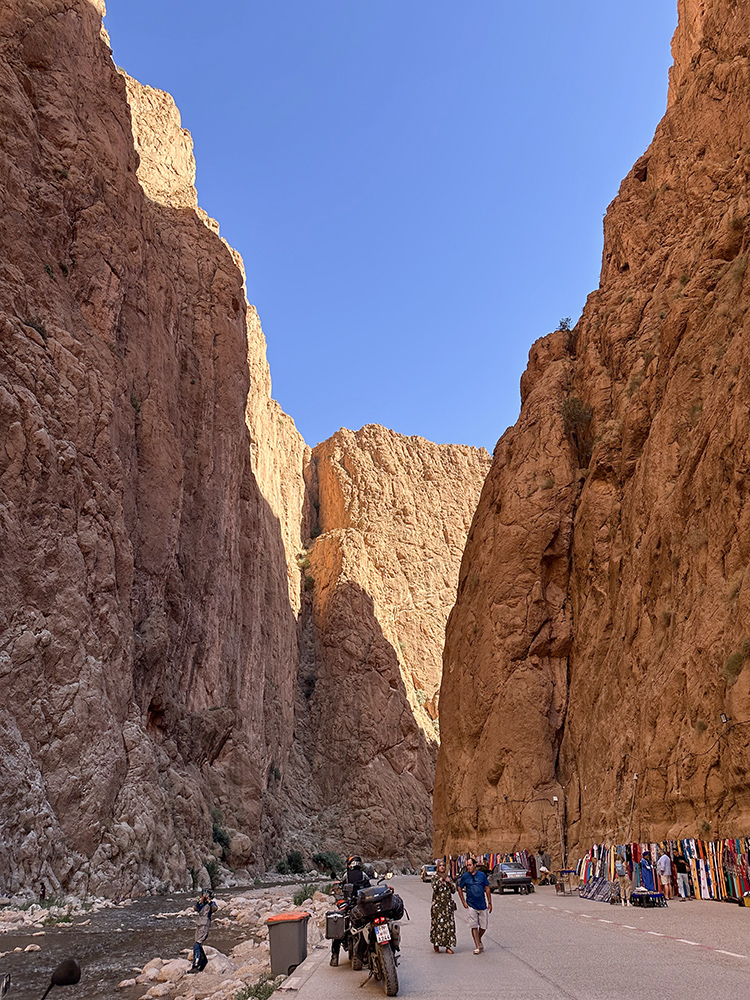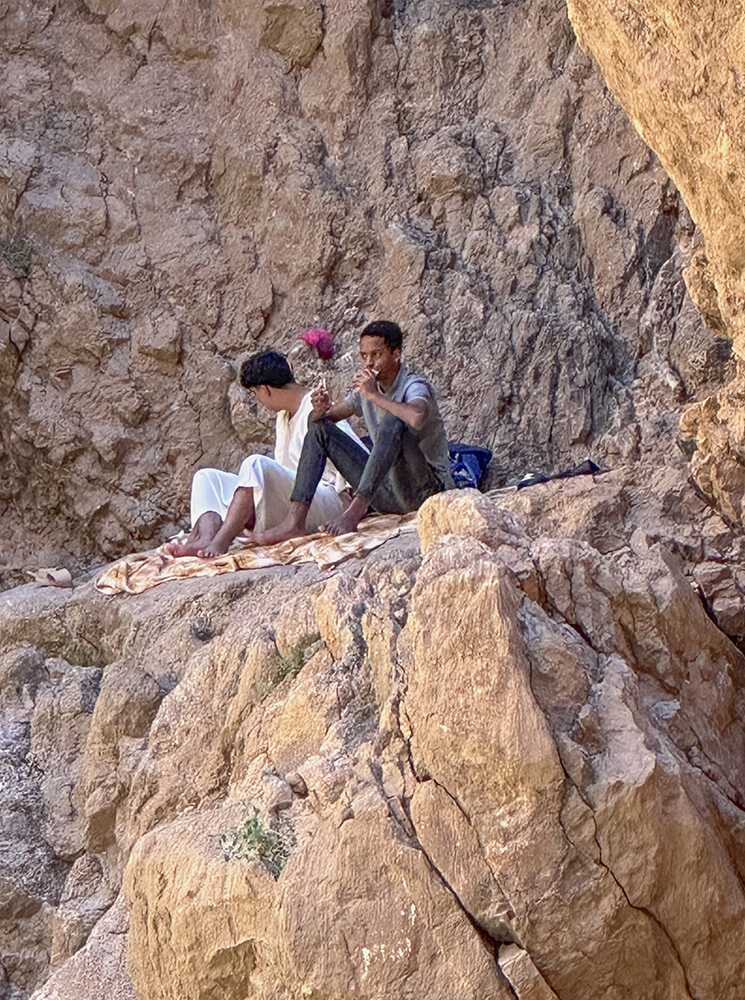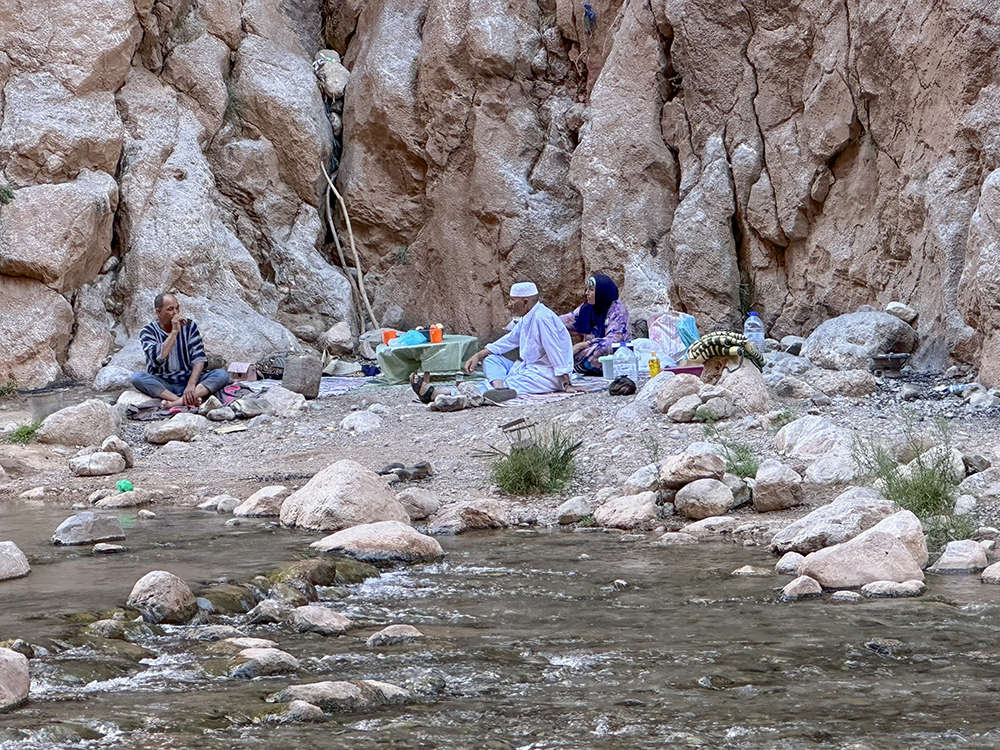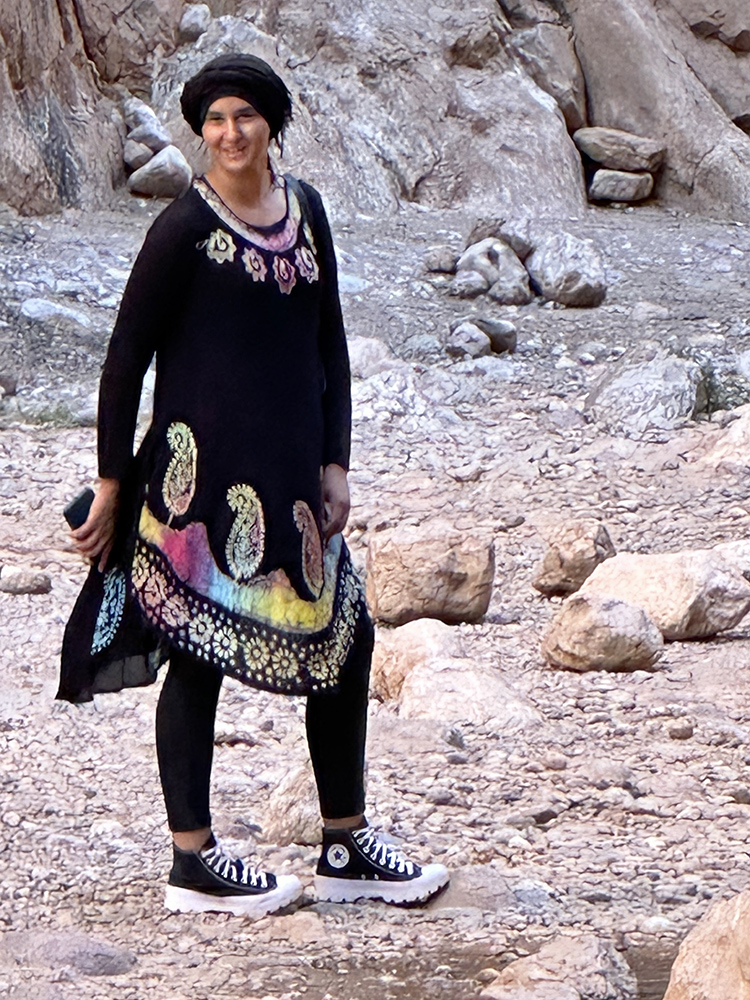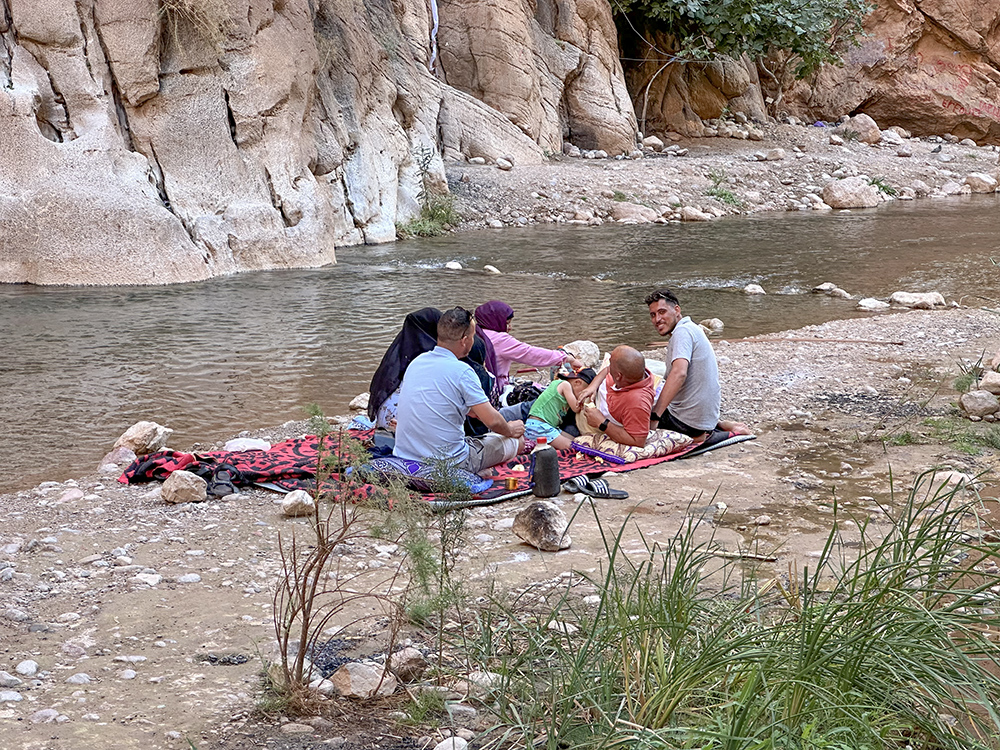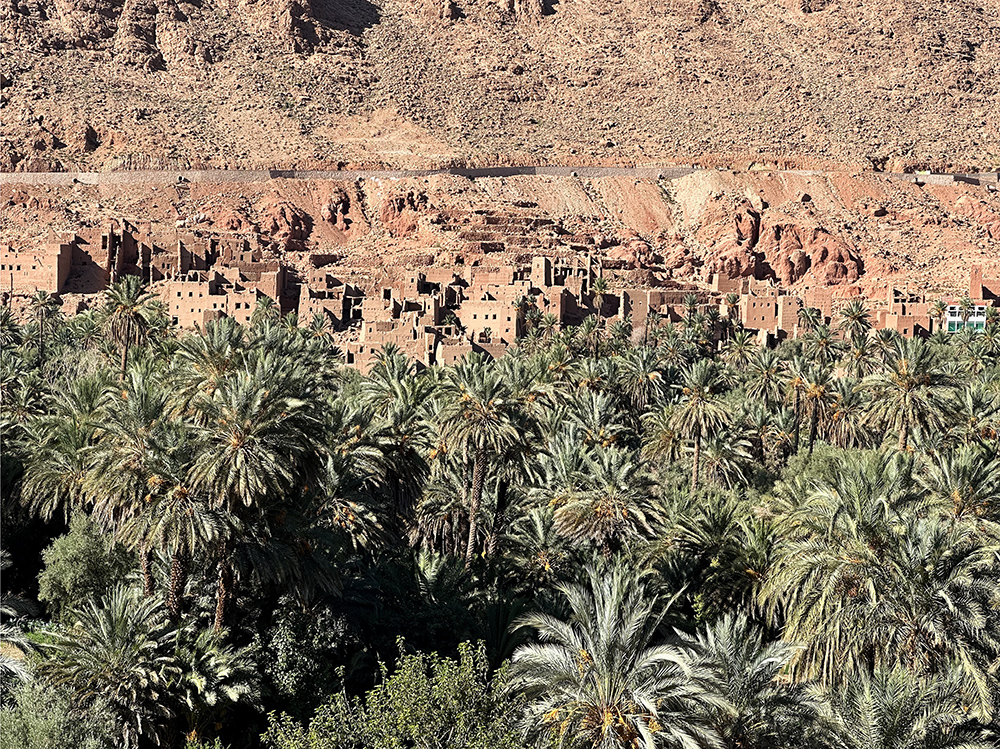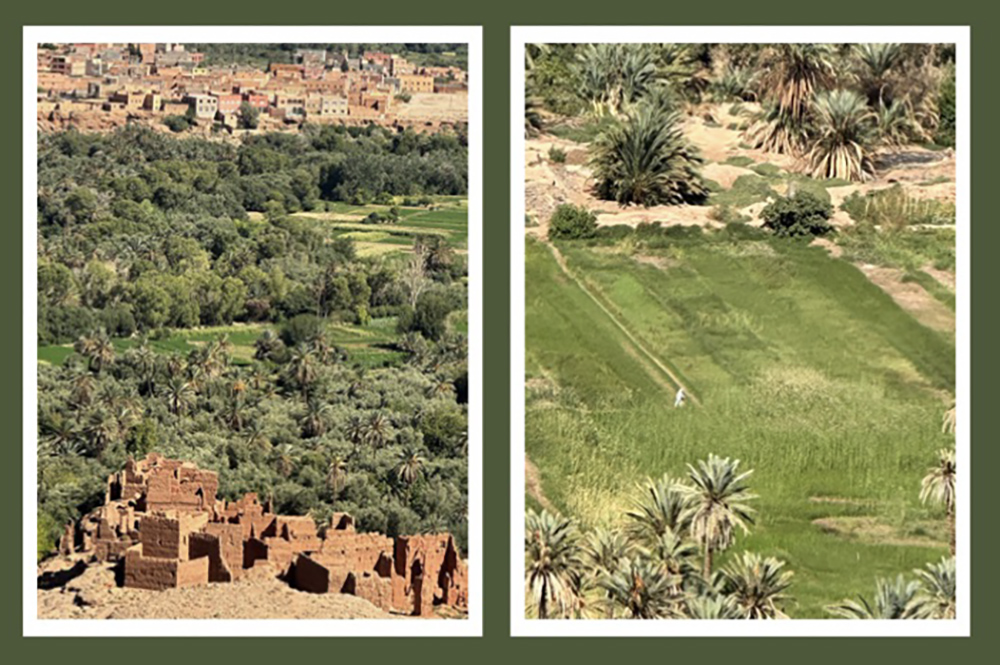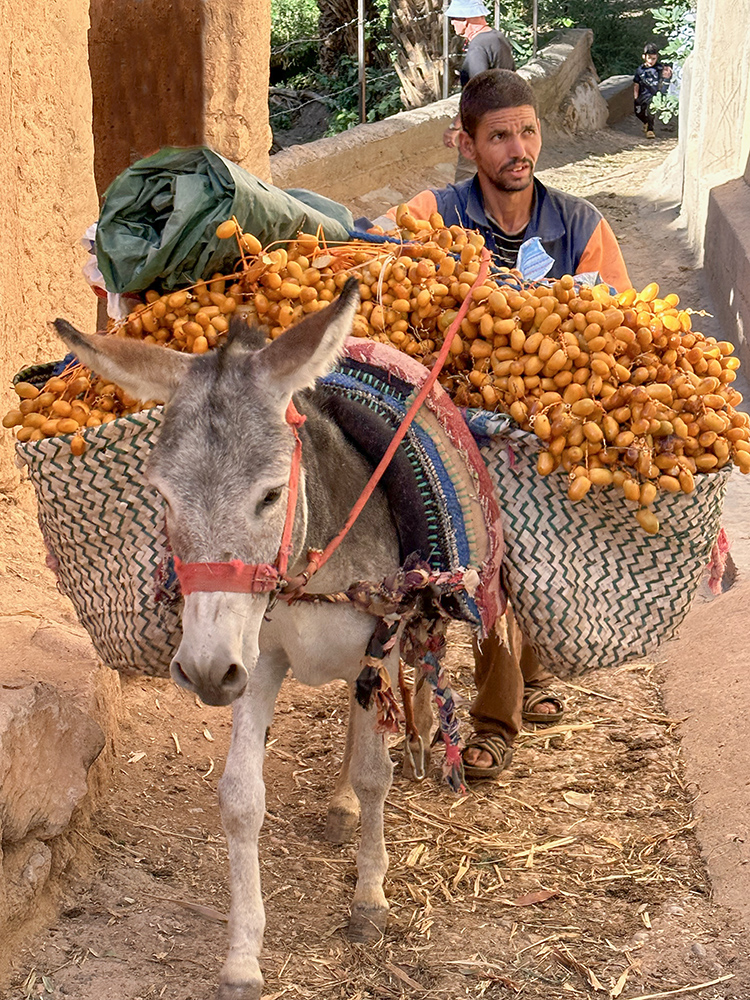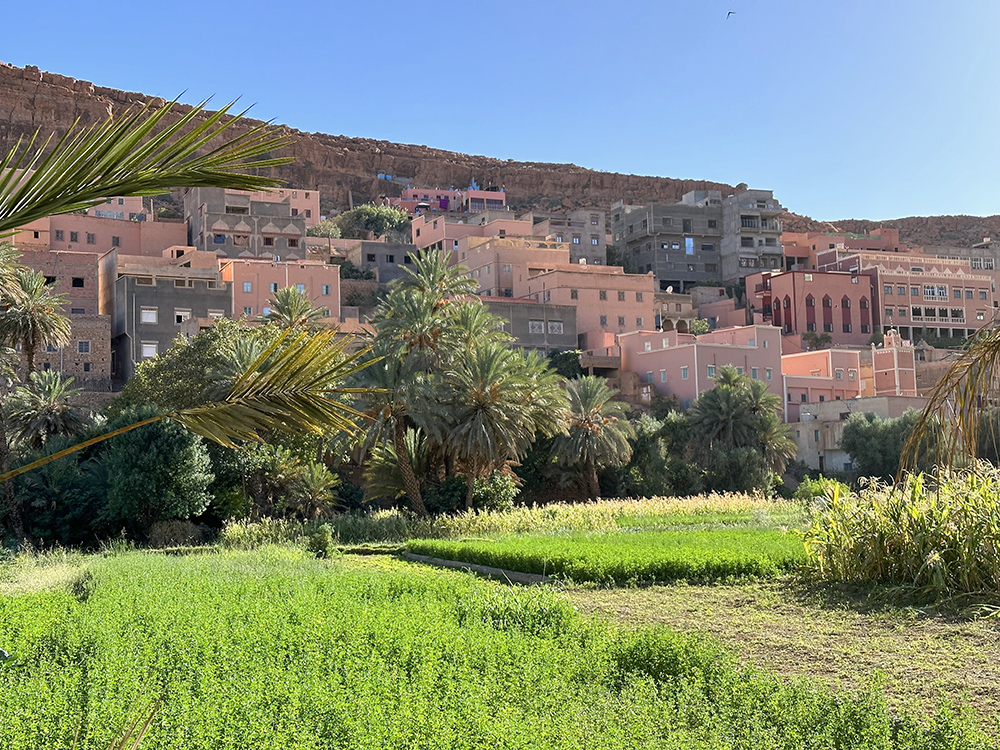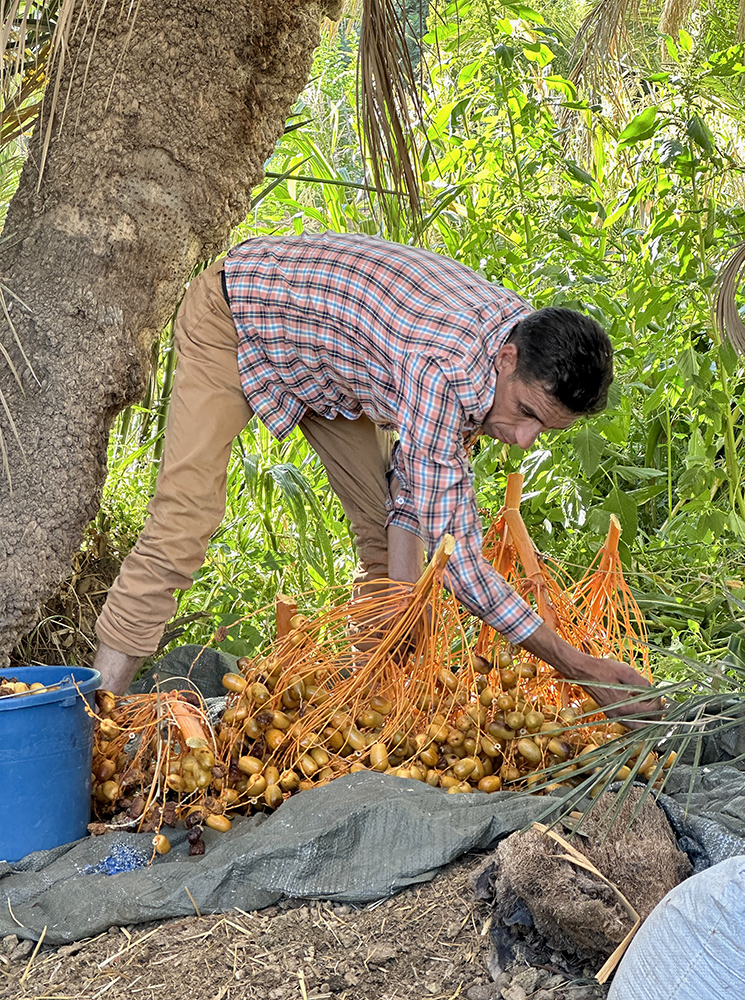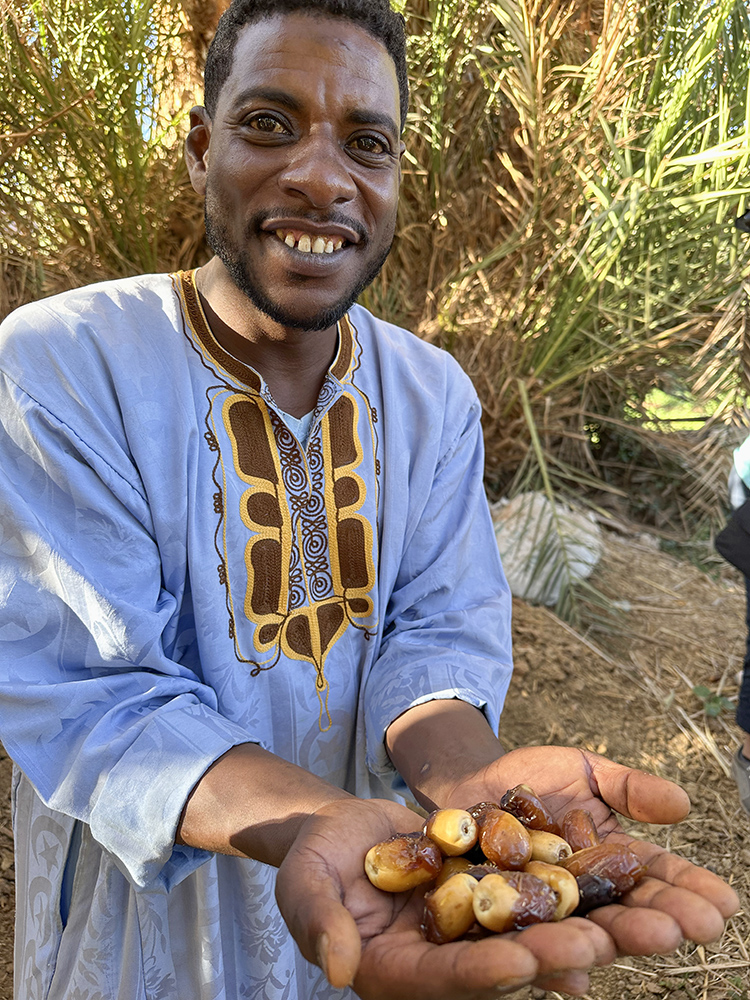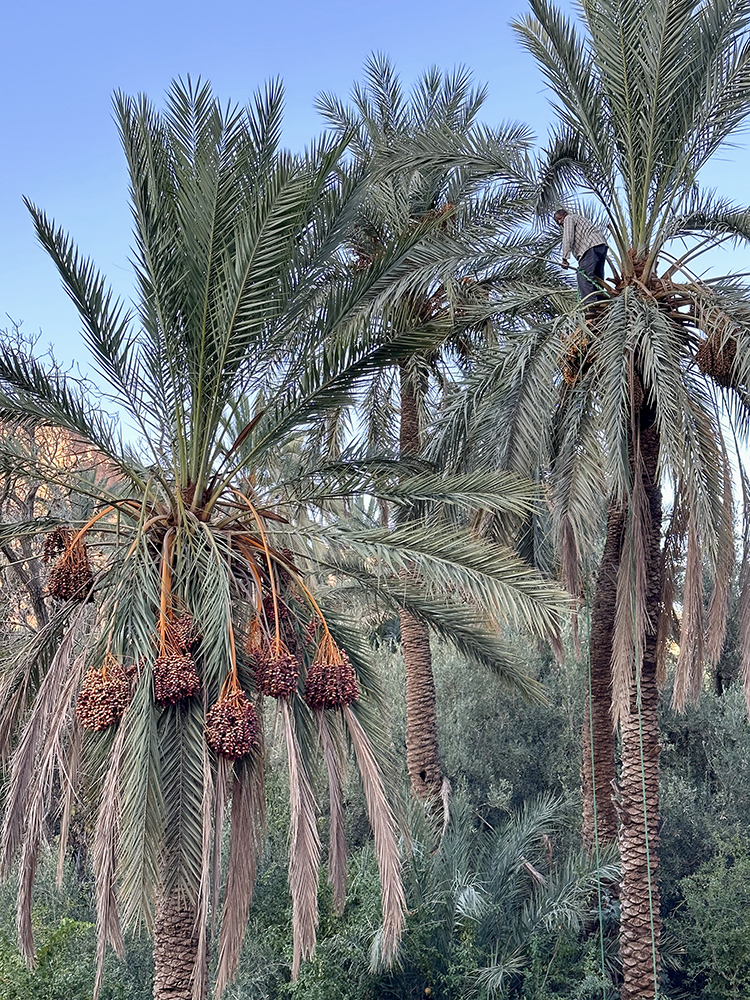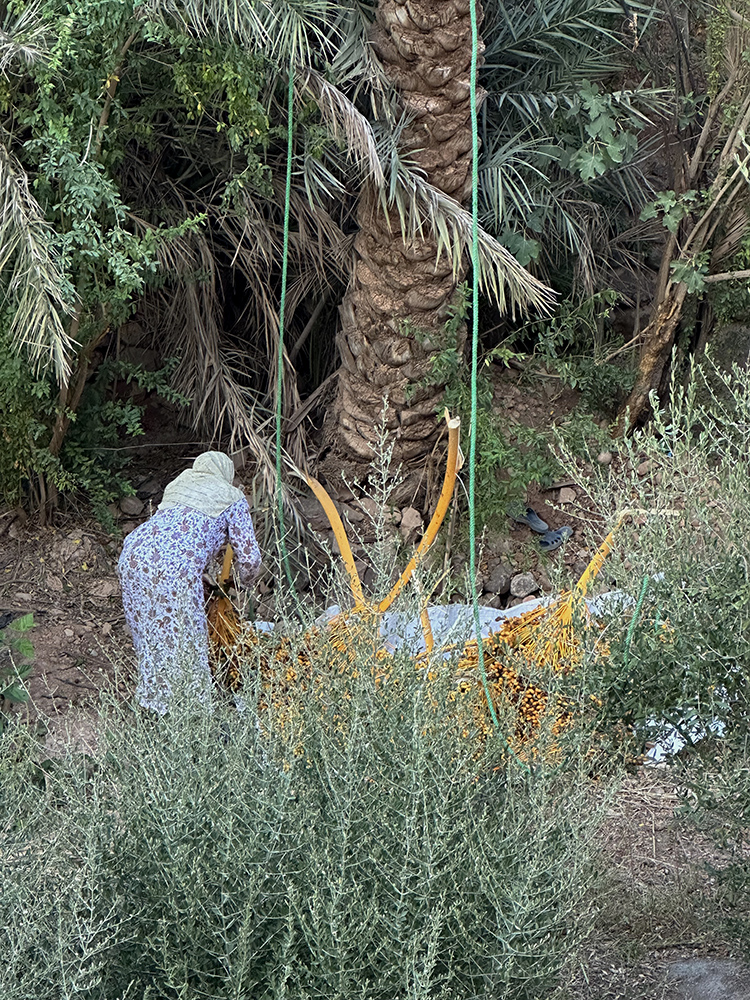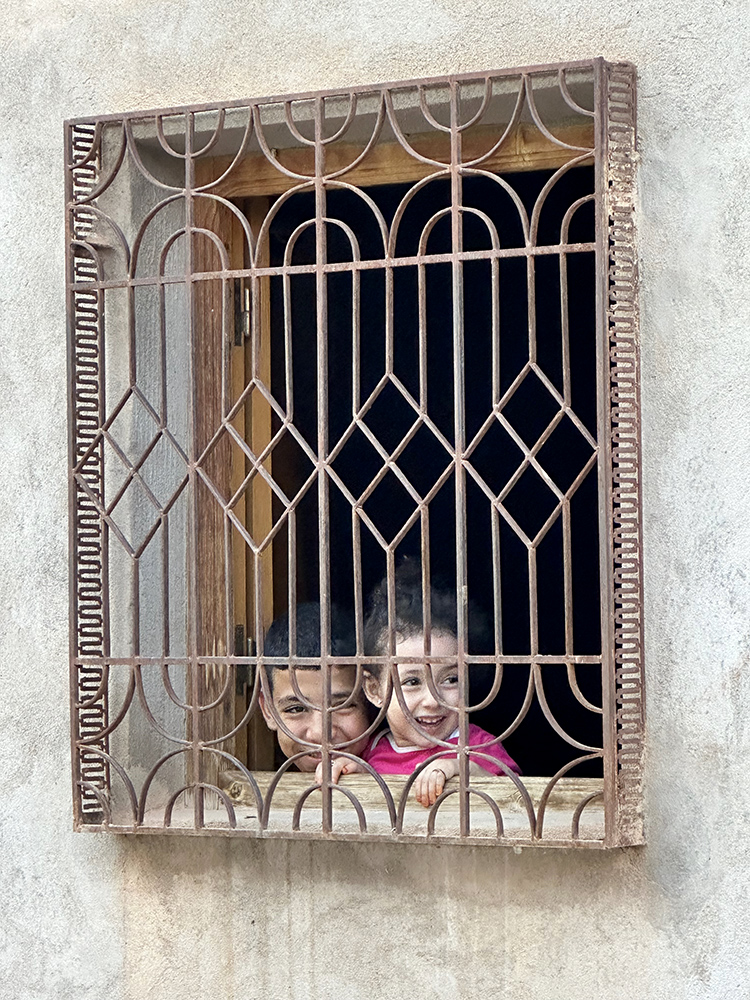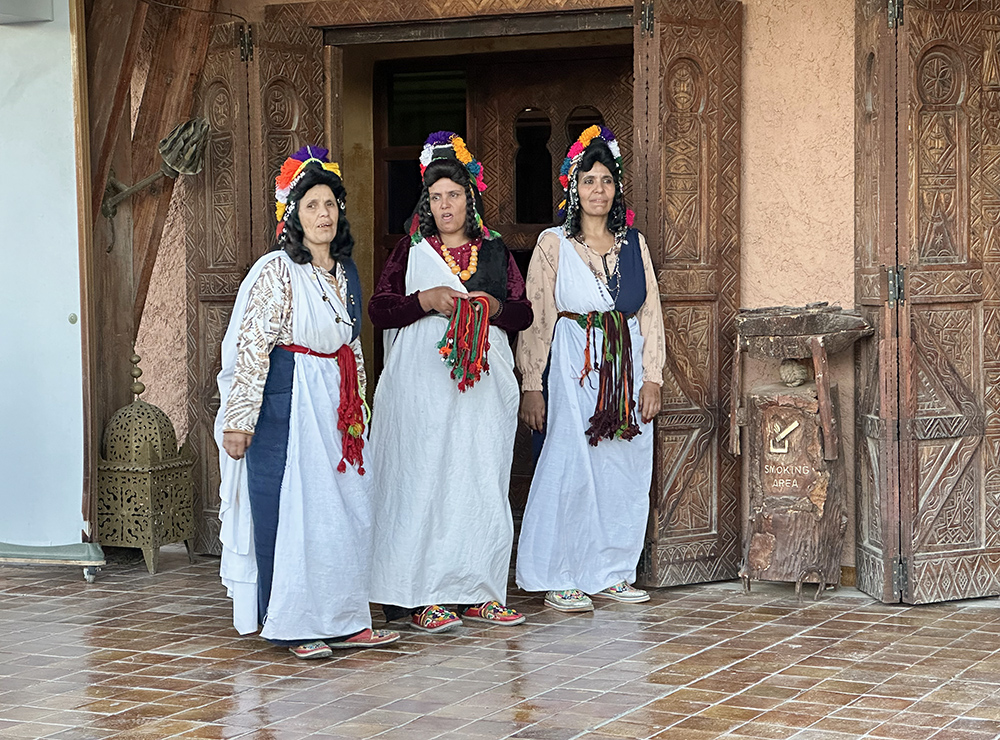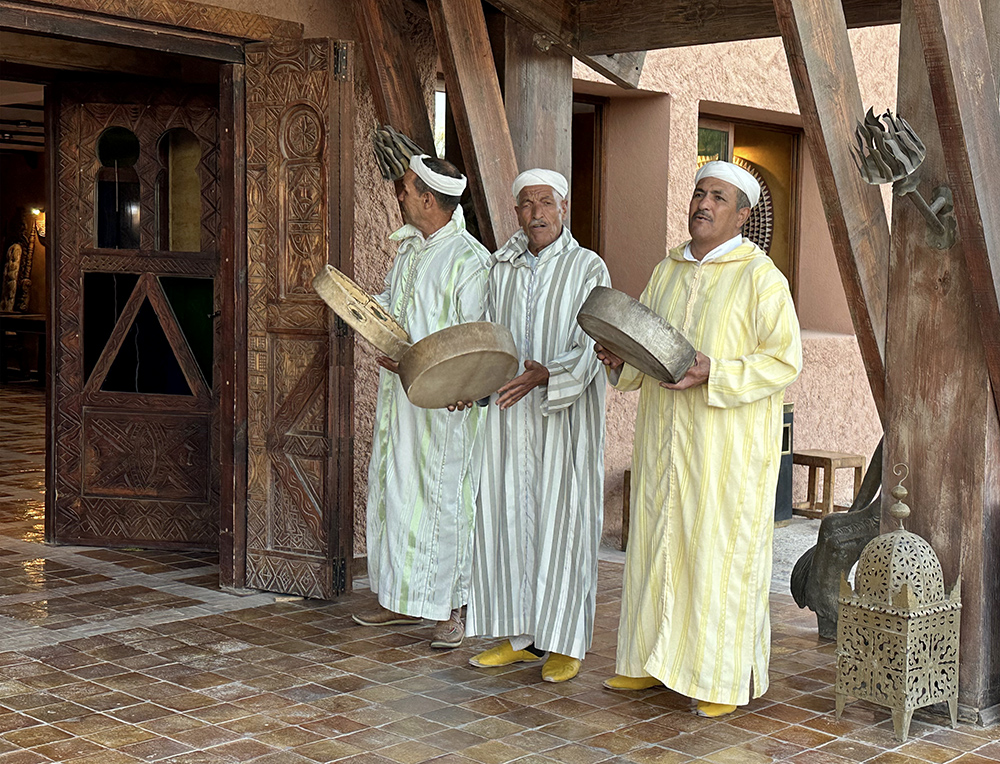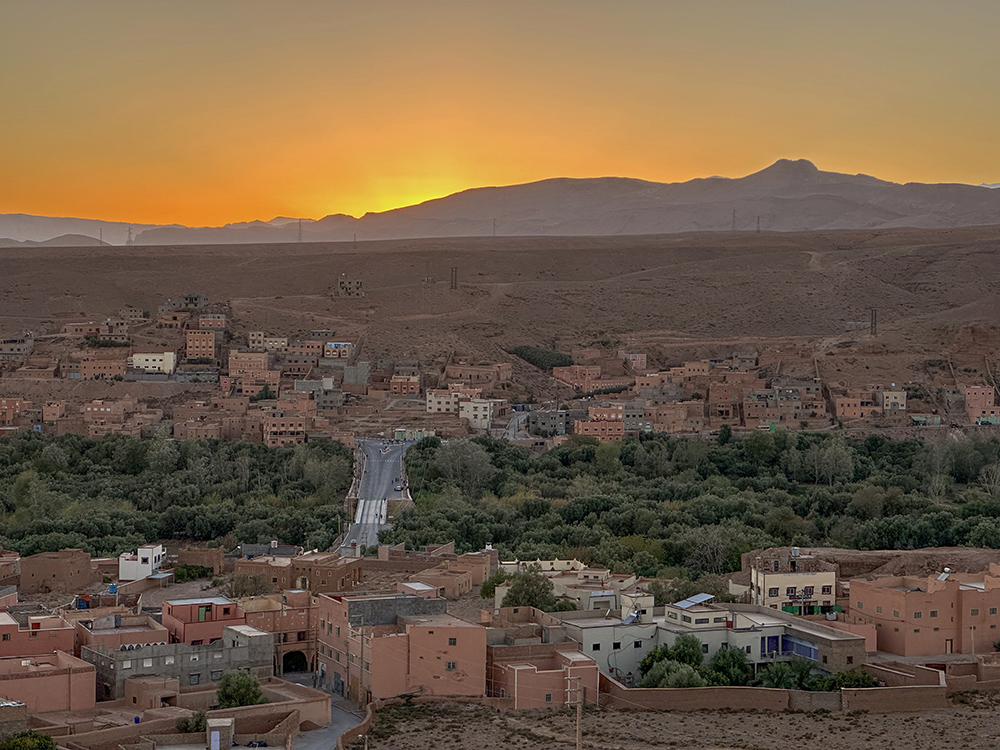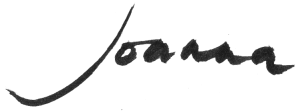Dear friends,
This journal entry will cover two days – our second day and evening at the camp and the following day when we farewelled the desert and travelled eastwards back towards the High Atlas Mountains visiting several villages, museums, a fertile valley with date palms, a dramatic gorge and then to our lodgings at the Hotel Xaluca Dades in the town of Boumalne Dades.
So back to the story of our days in the camp. We had been warned that it can become windy at night in the desert and sure enough at about 3 am the wind roared and gusted making the tents flap and billow. But we were up to see the sunrise early the next day and it was spectacular.
The sun rising over the sand dunes by our camp
A lovely reflection of the sunrise in Heidi’s glasses, wind clearly still blowing
All the lovely red carpets could hardly be seen under the new layer of sand blown over them in the night
Everything still being buffeted by the wind and a fine silt blowing across the dunes
New patterns emerging in the sand, and what a place from which to survey the landscape or find solitude
Camels patiently waiting for their drivers and riders
Just some camel portraits
The plan for the morning was to walk with the camels or ride if preferred to another part of the desert,
but most just wanted to walk with the camels, well covered and less exposed to the wind and flying sand.
So off they went. A few of us chose to stay in the camp for a couple more hours and travel by jeep to meet up with them
A couple more portraits of one of the camel drivers and his elegant white camel
A word here about the Sahara – the desert spanning North Africa. With an area of 9,200,000 square kilometres (3,600,000 sq mi), it is the largest hot desert in the world and the third-largest desert overall, smaller only than the deserts of Antartica and the northern Arctic. The Sahara covers large parts of Algeria, Chad, Egypt, Libya, Mali, Mauritania, Niger, Western Sahara, Sudan and Tunisia as well as Morocco.
The Sahara is mainly rocky stone plateaus; ergs (sand seas – large areas covered with sand dunes) form only a minor part, but many of the sand dunes are over 180 metres (590 ft) high. Wind or rare rainfall shape the desert features: sand dunes, dune fields, sand seas, stone plateaus, regs (gravel plains), dry valleys (wadi), dry lakes (oued), and salt flats (shatt or chott).
I was here – such a tourist photo!
The rocky terrain is more common then the more ‘picturesque’ sand dunes, and fossils abound in these rocks
You only have to walk a few meters before finding fossils in the rock fragments, such as this one
(more photos and info later in this blog after our visit to a fossil museum/shop)
A stark landscape of ergs (sand seas) and regs (gravel plains)
In spite of the barren terrain, the Moroccan desert is home to nomadic Berber families who make their home there, moving from site to site and staying in tents and shelters which can be shared between families on the move. We visited one such family and enjoyed some time being shown around by a small gang of boys and offered refreshment by their mother.
Excited and playful group of lads met us
One of the more permanent shelters used by the family
An adjacent storehouse with sacks of rice and other foodstuffs as well as bedding and tools
There were the kids and they showed us their kids as well – quite a sizable flock of goats
Like mother, like son – watching the visitors and telling us about their life, through our guide as translator
Cups of tea were on offer, but most declined. Mohamed quaffed a cup and thanked the family on behalf of us all
Back at our camp, we relaxed through the hottest part of the afternoon and then were treated to a demonstration of cooking with a tagine and moroccan spices by our chef.
The ingredients assembled, the spices cooked and the chicken and vegetables stacked just so, herbs sprinkled on top
And there you have it – the wonderful Moroccan chicken tagine
And then a demonstration on how to make the beautiful minted tea – who knew there were so many steps and pourings
It’s all in the wrist action, pouring the tea from a great height
We had a real treat later that evening with a delicious dinner in the cooler temps and a Gnaoua band performing for us. The Gnaoua are a religious brotherhood, and followers consider themselves to be the spiritual descendants of Bilal, and enslaved Ethiopian man whom the Prophet Mohamed set free before making him his muezzin (religious official)
Clad all in white, the musicians were introduced before their playing began
Drummers and a kind of castanets sounding out the rhythm
Singers all
As darkness fell they continued to play and afterwards invited us to dance with them
The camp under a glowing evening sky
The following day we had to leave the camp and after farewelling the camel drivers and camp staff, we climbed back into the four-wheel drive transport and were off on another day of interesting new places and experiences.
Early morning, such beautiful colours and shapes of the sand dunes by the camp.
We could appreciate why the Arabs called the Sahara – ‘bar bila maa’ – an ocean without water.
A tagine cooked breakfast of eggs with a chili for those who needed a spicy start to the day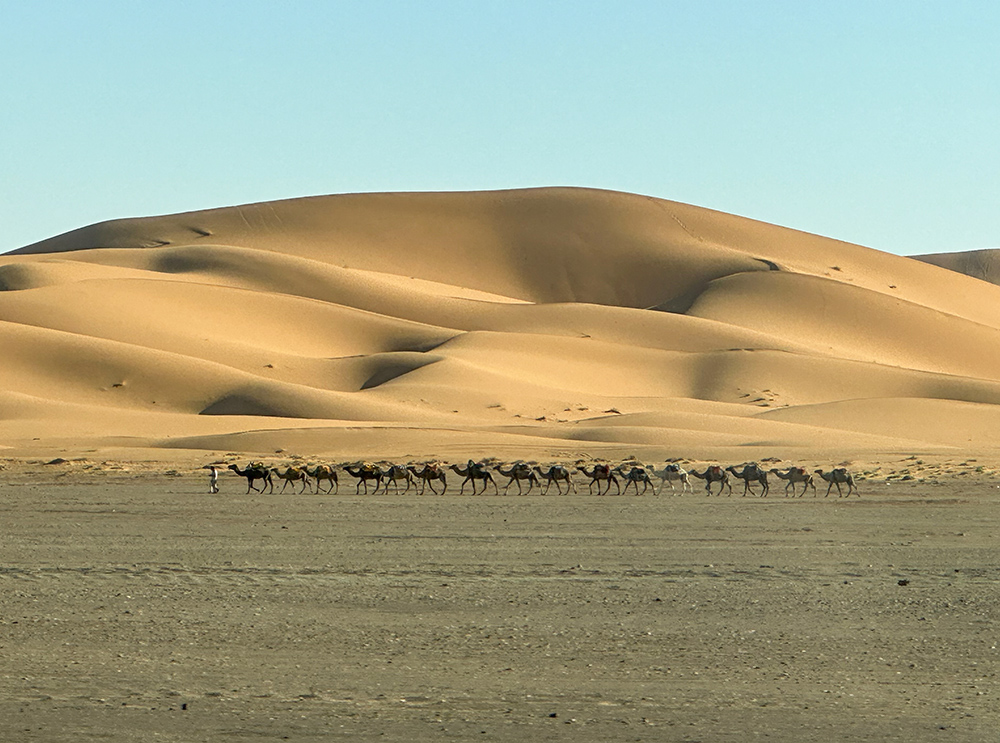
Lovely sight of a camel train as we drove across the desert …
… and I loved the lone man bicycling past them going the other way
Back into a more populated area …
and through the town of Rissani passing villagers on their way to market
Our first visit of the day was to a fossil factory and shop in the town of Erfoud, where we learnt of this important industry and could see for ourselves how the fossils looked in their raw state, pre-polishing and the final polished individual fossils and the way in which they are highlighted in tables and benches.
The Moroccan fossil trade is the large industry surrounding the excavation, preparation and international sale of fossils. Morocco contains some of the world’s richest fossil sites and has seen international interest from fossil collectors since the early 20th century. As interest in collecting fossils grew in the late 20th century, the Moroccan fossil trade grew into a lucrative industry of its own. More than 50,000 Moroccans earn their living in mining, trading or exporting fossils and the industry itself is worth more than $40 million annually. The booming industry is so big that some commentators have referred to it as “fossil capitalism” or a “tribolite economy”.
Trilobites are extinct marine arthropods that form the class Trilobita. Trilobites were among the most successful of all early animals, existing in oceans for almost 270 million years, with over 22,000 species having been described. Dinosaur fossils are also relatively common in Morocco
A tabletop, with scoring between the polished fossils
Some of the different fossil types
Absolutely stunning colours and forms – scored and polished to show them at their best
Another table top of fossils, set into a marble surround
Also prolific in the desert are impressive skeletons of dinosaurs such as this one
Later we stopped for a lunch break and visit to a museum in the town of Ferkla El Oulia and drove through the narrow streets with high walled buildings and a huge apartment-like complex with long alleyways and dwellings opening off the main passageway – all in shade and remarkably cool even in the noon heat.
Colorful blankets hung over the walls to air
A couple of women deep in conversation approaching us along one of the alleyways
The name of the museum in both plain script and the Berber script which is increasingly being used in this region
In the museum there was plenty to see and gave an interesting overview of the past and present rural life
Just a lovely open window with grasses beyond but also showing the breadth of the walls
The style of ovens and kitchenware are always interesting
As are the clothing and jewellery particular to each region
One of the passages in the huge complex housing many families
A handsome fellow was sitting and chatting with his friend, and was amused that I wanted a portrait of him
and also of his shoes which he had fashioned himself – very colour co-ordinated!
In an outer courtyard, I liked the modern youth and the old man – contrasting dress and attitude
And just a lovely photo of the elderly gentleman and his donkey coming in through the archway
He stopped to talk to our guide Mohamed who seemed to know everyone, and I was able to get another photo
Continuing our journey we passed through the town of Tinghir with impressive mud brick buildings
And then to a view point overlooking the city of Toudgha El Oulia with a fertile green valley running through it
Beautifully manicured terraces between the palm and other crop bearing trees
Before we took some time to walk through another part of this fertile valley, we drove on to the famous Todra Gorge, a narrow cleft between mighty cliffs with a river running through it. Lots of local families as well as tourists were sauntering, shopping for clothes and souvenirs and picnicing there.
Looking along the gorge
A couple of lads had found perch high up on the cliff wall
A family group on a little shingle beach for an afternoon snack
A rather modern miss showing off her new sneakers
A family picnic by the river
Next stop was in the town of Imarirhen where we walked through the village and into the green irrigated river valley below
Lovely colours – the ochre of the mud brick contrasting with the vivid green of the irrigated farmlands
A farmer and his donkey laden with his crop of dates walking up through the village
A more modern and prosperous line of houses along the valley
Harvesting the dates
Proudly showing them to us to try
Not for the faint-hearted, this man was high in the date palm cutting the long branches bearing the dates
His wife below, collecting the branches and harvesting the dates
Leaving the village after our walk through the valley, I caught sight of these two kids looking out at us
Arriving at our hotel in Boumalne Dades for the next two night’s stay, we were greeted by a group of singers …
… and percussionists wishing us a pleasant stay
The view over the town of Boumalne Dades from my room with the sun setting over the Atlas Mountains
I hope you enjoyed this story encompassing scenes from the desert, the towns, the gorge and the date palm oasis, and some of the people we met on the way.
In the next journal entry we venture higher into the mountains, meet another Berber family and visit the famous mountain village of Ait Zineb, before descending into the plains towards the city of Marrakesh. Then the final two stories will be about Marrakesh and the Atlantic Coast city of Essaouira.
Until soon, all good wishes to you my friends and followers
